A Novel Robust Methodology Based Salp Swarm Algorithm for Allocation and Capacity of Renewable Distributed Generators on Distribution Grids
Abstract
1. Introduction
2. Work
2.1. Power-Flow Executing with RDGs and SCBs
2.2. Formulation of Power and Energy Losses with RDGs and SCBs
2.3. Power Loss Index (PLI)
2.4. Voltage-Level Index
2.5. Whole Operational-Cost Estimations
2.6. Voltage Stability
2.6.1. Voltage Stability Definition
2.6.2. VSI Analysis
2.7. Derivation of the Objective Function
Constrains of the Objective Function
2.8. Sensibility Factors Analysis for RDGs and SCBs Location
2.9. Types of Studied RDGs
3. Salp Swarm Algorithm-Based Strategy
4. Simulation Investigation Results
5. The Egyptian System
5.1. Simulation Characteristics of the PV and WT Systems for MEDN
5.2. The Simulation Results of the MEDN Case Study
6. Conclusions
Author Contributions
Conflicts of Interest
Nomenclature
| N | Number of branches |
| , | The active and reactive power that flows through branch ‘N’. |
| , | The active and reactive power that are estimated at bus ‘j’. |
| , | Active and reactive load that are connected at node ‘j’. |
| The active power parameter that is set to 1 if there is an injected active power source (DG) or set to zero if there is no injected active power. | |
| Reactive power parameter that is equal to 1 if there is an injected reactive power source (SCB), or equal to zero if there is no injected reactive power. | |
| Reactive power parameter that is equal to 1 if there is an injected reactive power source (DG), or equal to zero if there is no reactive power injection. | |
| nb | Number of buses. |
| i | 1: nb (No of buses). |
| Base total active power losses. | |
| The time in hours. | |
| Ke | The energy cost rate ($/MWh). |
| ETLoss,b | Base total active energy loss cost. |
| InfR | Inflation rate (9%). |
| IntR | Interest rate (12.5%) |
| Tpp | Planning period time represented as 20 years. |
| ty | Number of years (1: Tpp) |
| PDGC(I,j), QDGC(i,j) | Active and reactive power with DGs and/or SCBs that flow through a sample branch. |
| PDGC,Loss(i,j) | Active power losses with DGs and/or SCBs. |
| PDGC,TLoss | Total active power losses after locating DGs and/or SCBs. |
| EDGSCB,TLoss | Total active energy loss cost after installing DGs and/or SCBs. |
| ΔPlDGSCB | Power loss index. |
| ViDGSCB | Per-unit voltage at i-bus after installing the DGs and/or SCBs. |
| Vmax, Vmin | Maximum and minimum voltage limits. |
| Emp | Electricity market price ($/MWh). |
| Pdem, Qdem | The total active and reactive power demand of the network. |
| PTLoad, QTLoad | Total active and reactive power load of the network (MW). |
| , , Parameter considered as the weight factors of the objective function. | |
| KSCB | Purchase cost of capacitor (3 $/kVAr). |
| ΔVIDev | Voltage deviation index. |
| The value of installed reactive power (kVAr) at the j-location. | |
| Kb | The number of the capacitor position |
| Kf | The cost per installation (1000 $/position). |
| Coefficient operation and maintenance cost of capacitor (300 $/position/year). | |
| Coefficient operation and maintenance cost of DG (36 $/MWh) | |
| KDG | Purchase cost of DG (400,000 $/MW). |
| DG capacity (MVA). | |
| The value of the injected active power (MW) at j-location. | |
| ΔOCDGSCB | Cost index (net operating cost). |
| PTLoss | Total active power losses of the network (MW). |
| TOCT,DGSCB | Total annual operating cost with DGs and SCBs locations. |
| VSI | Voltage stability index. |
| The maximum limit of the voltage drop. | |
| V1 | Base per unit voltage. |
| LSF | Loss sensitivity factor. |
| ViDGSCB | Per-unit voltage at i-bus after installing the DGs and/or SCBs. |
| Emp | Electricity market price ($/MWh). |
| Pdem, Qdem | The total active and reactive power demand of the network. |
| PTLoad, QTLoad | Total active and reactive power load of the network (MW). |
| , , Parameter considered as the weight factors of the objective function. | |
| KSCB | Purchase cost of capacitor (3 $/kVAr). |
References
- Aman, M.M.; Jasmon, G.B.; Bakar, A.H.A.; Mokhlis, H.; Karimi, M. Optimum shunt capacitor placement in distribution system—A review and comparativestudy. Renew Sustain. Energy Rev. J. 2014, 30, 429–439. [Google Scholar] [CrossRef]
- Tolba, M.A.; Zaki, D.A.A.; Tulsky, V.N.; Abdelaziz, A.Y. VLCI approach for optimal capacitors allocation in distribution networks based on hybrid PSOGSA optimization algorithm. Neural Comput. Appl. J. 2018. [Google Scholar] [CrossRef]
- Kalambe, S.; Aggnihotri, G. Loss minimization techniques used in distribution network: Bibliographical survey. Renew. Sustain. Energy Rev. J. 2014, 29, 184–200. [Google Scholar] [CrossRef]
- Hosseinzadeh, M.; Salmasi, F.R. Power management of an isolated hybrid AC/DC micro-grid with fuzzy control of battery banks. IET Renew. Power Gener. 2015, 9, 484–493. [Google Scholar] [CrossRef]
- Li, M.; Zhang, X.; Zhao, W. A Novel Stability Improvement Strategy for a Multi-Inverter System in a Weak Grid Utilizing Dual-Mode Control. Energies 2018, 11, 2144. [Google Scholar] [CrossRef]
- El-Fergany, A. Optimal allocation of multi-type distributed generators using backtracking search optimization algorithm. Electr. Power Energy Syst. 2015, 64, 1197–1205. [Google Scholar] [CrossRef]
- Sultana, U.; Khairuddin, A.B.; Aman, M.M.; Mokhtar, A.S.; Zareen, N. A review of optimum DG placement based on minimization of power losses and voltage stability enhancement of distribution system. Renew. Sustain. Energy Rev. 2016, 63, 363–378. [Google Scholar] [CrossRef]
- Niknam, T. A new approach based on ant colony optimization for daily Volt/Var control in distribution networks considering distributed generators. Energy Convers. Manag. 2008, 49, 3417–3424. [Google Scholar] [CrossRef]
- Abdelaziz, A.; Hegazy, Y.; El-Khattam, W.; Othman, M. A multi-objective optimization for sizing and placement of voltage-controlled distributed generation using supervised Big Bang-Big Crunch method. Electr. Power Com. Syst. 2015, 43, 105–117. [Google Scholar] [CrossRef]
- Oneto, L.; Laureri, F.; Robba, M.; Delfino, F.; Anguita, D. Data-Driven Photovoltaic Power Production Nowcasting and Forecasting for Polygeneration Microgrids. IEEE Syst. J. 2017, 12, 2842–2853. [Google Scholar] [CrossRef]
- Sudabattula, S.K.; Kowsalwa, M. Optimal allocation of wind-based distributed generators in distribution system using Cuckoo Search Algorithm. Procedia Comput. Sci. 2016, 92, 298–304. [Google Scholar] [CrossRef]
- Georgilakis, P.S.; Hatziargyriou, N.D. Optimal Distributed Generation Placement in Power Distribution Networks: Models, Methods, and Future Research. IEEE Trans Power Syst. 2013, 28, 3420–3428. [Google Scholar] [CrossRef]
- Tulsky, V.N.; Vanin, A.S.; Tolba, M.A.; Sharova, A.; Zaki, D.A.A. Study and analysis of power quality for an electric power distribution system—Case study: Moscow region. In Proceedings of the 2016 IEEE NW Russia Young Researchers in Electrical and Electronic Engineering Conference (EIConRusNW), St. Petersburg, Russia, 2–3 February 2016; pp. 710–716. [Google Scholar]
- Tolba, M.A.; Tulsky, V.N.; Vanin, A.S.; Zaki, D.A.A. Comprehensive analysis of optimal allocation of capacitor banks in various distribution networks using different hybrid optimization algorithms. In Proceedings of the 2017 IEEE International Conference on Environment and Electrical Engineering and 2017 IEEE Industrial and Commercial Power Systems Europe (EEEIC/I&CPS Europe), Milan, Italy, 6–9 June 2017. [Google Scholar] [CrossRef]
- El-Fergany, A.A.; Abdelaziz, A.Y. Cuckoo search-based algorithm for optimal shunt capacitors allocations in distribution networks. Electr. Power Compon. Syst. 2013, 41, 1567–1581. [Google Scholar] [CrossRef]
- Abdelaziz, A.; Hegazy, Y.; El-Khattam, W.; Othman, M. Optimal Planning of Distributed Generators in Distribution Networks Using Modified Firefly Method. Electr. Power Compon. Syst. 2015, 43, 3. [Google Scholar] [CrossRef]
- Sudabattula, S.K.; Kowsalwa, M. Optimal allocation of solar based distributed generators in distribution system using bat algorithm. Perspect. Sci. 2016, 8, 270–272. [Google Scholar] [CrossRef]
- Hung, D.Q.; Mithulananthan, N.; Lee, K.Y. Optimal placement of dispatchable and nondispatchable renewable DG units in distribution networks for minimizing energy loss. Int. J. Electr. Power Energy Syst. 2014, 55, 179–186. [Google Scholar] [CrossRef]
- Kansal, S.; Vishal, K.; Tyagi, B. Composite active and reactive power compensation of distribution networks. In Proceedings of the 2012 IEEE 7th International Conference on Industrial and Information Systems (ICIIS), Chennai, India, 6–9 August 2012. [Google Scholar] [CrossRef]
- Reddy, S.C.; Prasad, P.V.N.; Laxmi, A.J. Placement of distributed generator, capacitor and DG and capacitor in distribution system for loss reduction and reliability improvement. J. Electr. Eng. 2013, 1–9, 198. [Google Scholar]
- Naik, S.; Khatod, D.; Sharma, M. Optimal allocation of combined DG and capacitor for real power loss minimization in distribution networks. Int. J. Electr. Power Energy Syst. 2013, 53, 967–973. [Google Scholar] [CrossRef]
- Aman, M.M.; Jasmon, G.B.; Solangi, K.H.; Bakar, A.H.A.; Mokhlis, H. Optimum Simultaneous DG and Capacitor Placement on the Basis of Minimization of Power Losses. Int. J. Comput. Electr. Eng. 2013. [Google Scholar] [CrossRef]
- Kansal, S.; Kumar, V.; Tyagi, B. Optimal Placement of different type of DG sources in distribution network. Int. J. Electr. Power Energy Syst. 2013, 53, 752–760. [Google Scholar] [CrossRef]
- Imran, M.A.; Kowsalya, M. Optimal distributed generation and capacitor placement in power distribution networks for power loss minimization. In Proceedings of the 2014 International Conference on Advances in Electrical Engineering (ICAEE), Vellore, India, 9–11 January 2014. [Google Scholar]
- Zeinalzadeh, A.; Mohammadi, Y.; Moradi, M.H. Optimal multi objective placement and sizing of multiple DGs and Shunt Capacitor Banks Simultaneously Considering Load Uncertainty via MOPSO approach. Electr. Power Energy Syst. 2015, 67, 336–349. [Google Scholar] [CrossRef]
- Muthukumar, K.; Jayalalitha, S. Optimal Placement and Size of Distributed Generators and Shunt Capacitors for Power Loss Minimization in Radial Distribution Networks using Heuristic Search Optimization Technique. Electr. Power Energy Syst. 2016, 78, 299–319. [Google Scholar] [CrossRef]
- Khodabakhshian, A.; Andishgar, M.H. Simultaneous Placement and Sizing of DGs and Shunt Capacitors in Distribution Systems by Using IMDE algorithm. Electr. Power Energy Syst. 2016, 82, 599–607. [Google Scholar] [CrossRef]
- Dixit, M.; Kundu, P.; Jariwala, H.R. Incorporation of Distributed Generation and Shunt Capacitor in Radial Distribution System for Techno-Economic Benefits. Eng. Sci. Tech. Int. J. 2017, 20, 482–493. [Google Scholar] [CrossRef]
- El-Fergany, A.A.; Abdelaziz, A.Y. Efficient heuristic-based approach for multi-objective capacitor allocation in radial distribution networks. IET Gener. Transm. Distrib. 2014, 8, 79–80. [Google Scholar] [CrossRef]
- Moradi, M.N.; Abedini, M. A combination of genetic algorithm and particle swarm optimization for optimal DG location and sizing in distribution systems. Electr. Power Energy Syst. 2012, 34, 66–74. [Google Scholar] [CrossRef]
- Devabalaji, K.R.; Yuvaraj, T.; Ravi, K. An efficient method for solving the optimal sitting and sizing problem of capacitor banks based on cuckoo search algorithm. Ain Shams Eng. J. 2016. [Google Scholar] [CrossRef]
- Ali, E.S.; Abd Elazim, S.M.; Abdelaziz, A.Y. Ant Lion Optimization Algorithm for optimal location and sizing of renewable distributed generations. Renew. Energy J. 2017, 101, 1311–1324. [Google Scholar] [CrossRef]
- Rezk, H.; Tyukhov, I.; Raupov, A. Experimental implementation of meteorological data and photovoltaic solar radiation monitoring system. Int. Trans. Electr. Energy Syst. 2015, 25, 3573–3585. [Google Scholar] [CrossRef]
- Rezk, H.; Tyukhov, I.; Al-Dhaifallah, M.; Tikhonov, A. Performance of data acquisition system for monitoring PV system parameters. Measurement 2017, 104, 204–211. [Google Scholar] [CrossRef]
- Shiroudi, A.; Taklimi, S.; Mousavifar, S.; Taghipour, P. Stand-alone PV-hydrogen energy system in Taleghan-Iran using HOMER software: Optimization and technoeconomic analysis. Environ. Dev. Sustain. J. 2013, 15, 1389–1402. [Google Scholar] [CrossRef]
- Benyahia, N.; Denoun, H.; Badji, A.; Zaouia, M.; Rekioua, T.; Benamrouche, N.; Rekioua, D. MPPT controller for an interleaved boost dc-dc converter used in fuel cell electric vehicles. Int. J. Hydrogen Energy 2014, 39, 15196–15205. [Google Scholar] [CrossRef]
- Maher, A.R.; Al-Baghdadi, S. Modelling of proton exchange membrane fuel cell performance based on semi-empirical equations. Renew. Energy 2005, 30, 1587–1599. [Google Scholar]
- Lee, J.H.; Lalk, T.R.; Appleby, A.J. Modeling electrochemical performance in large scale proton exchange membrane fuel cell stacks. J. Power Sources 1998, 70, 258–268. [Google Scholar] [CrossRef]
- Mirjalili, S.; Gandomi, A.; Mirjalili, S.Z.; Saremi, S.; Faris, H.; Mirjalili, S.M. Salp Swarm Algorithm: A bio-inspired optimizer for engineering design problems. Adv. Eng. Softw. J. 2017, 114, 163–191. [Google Scholar] [CrossRef]
- Madin, L. Aspects of jet propulsion in salps. Can. J. Zool. 1990, 68, 765–777. [Google Scholar] [CrossRef]
- Anderson, P.A.; Bone, Q. Communication between individuals in salp chains II. physiology. Proc. R Soc. B. 1980. [Google Scholar] [CrossRef]
- Wolpert, D.H.; Macready, W.G. No free lunch theorems for optimization. IEEE Trans. Evol. Comput. 1997, 1, 67–82. [Google Scholar] [CrossRef]
- Mohamed, M.A.; Diab, A.A.Z.; Rezk, H. Partial Shading Mitigation of PV Systems via Different Meta-Heuristic Techniques. Renew. Energy 2018, 130, 1159–1175. [Google Scholar] [CrossRef]
- Sajjadi, S.M.; Haghifam, M.R.; Salehi, J. Simultaneous placement of distributed generation and capacitors in distribution networks considering voltage stability index. Power Energy Syst. 2013, 46, 366–375. [Google Scholar] [CrossRef]
- Tolba, M.A.; Rezk, H.; Tulsky, V.; Diab, A.A.Z.; Abdelaziz, A.Y.; Vanin, A. Impact of Optimum Allocation of Renewable Distributed Generations on Distribution Networks Based on Different Optimization Algorithms. Energies 2018, 11, 245. [Google Scholar] [CrossRef]
- NASA database. Available online: https://eosweb.larc.nasa.gov/sse/ (accessed on 15 October 2017).
- Homer software. Available online: https://www.homerenergy.com/homer-pro.html (accessed on 12 January 2018).
- Hadidian-Moghaddam, M.J.; Arabi-Nowdeh, S.; Bigdeli, M.; Azizian, D. A multi-objective optimal sizing and siting of distributed generation using ant lion optimization technique. Ain Shams Eng. J. 2017. [Google Scholar] [CrossRef]

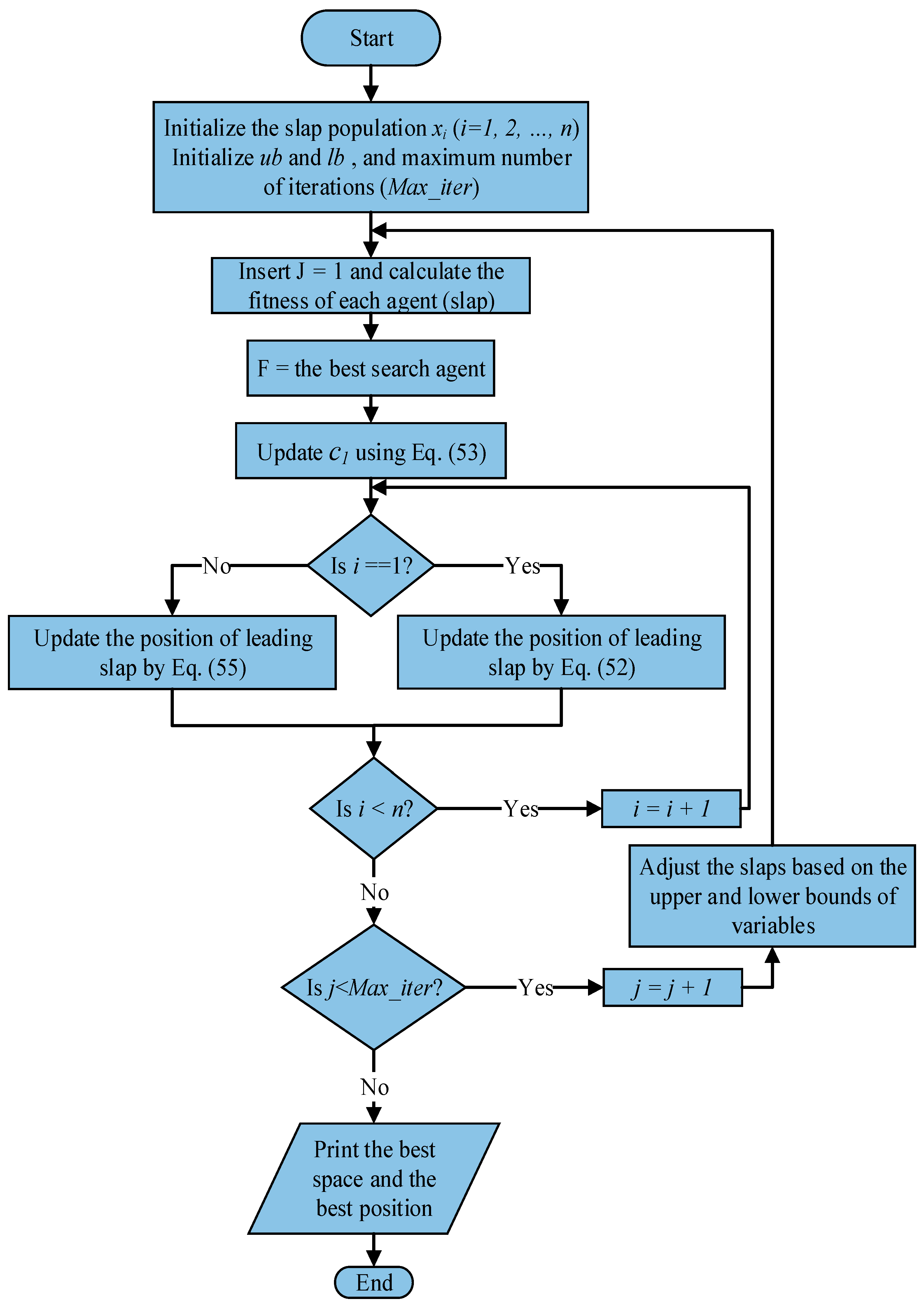


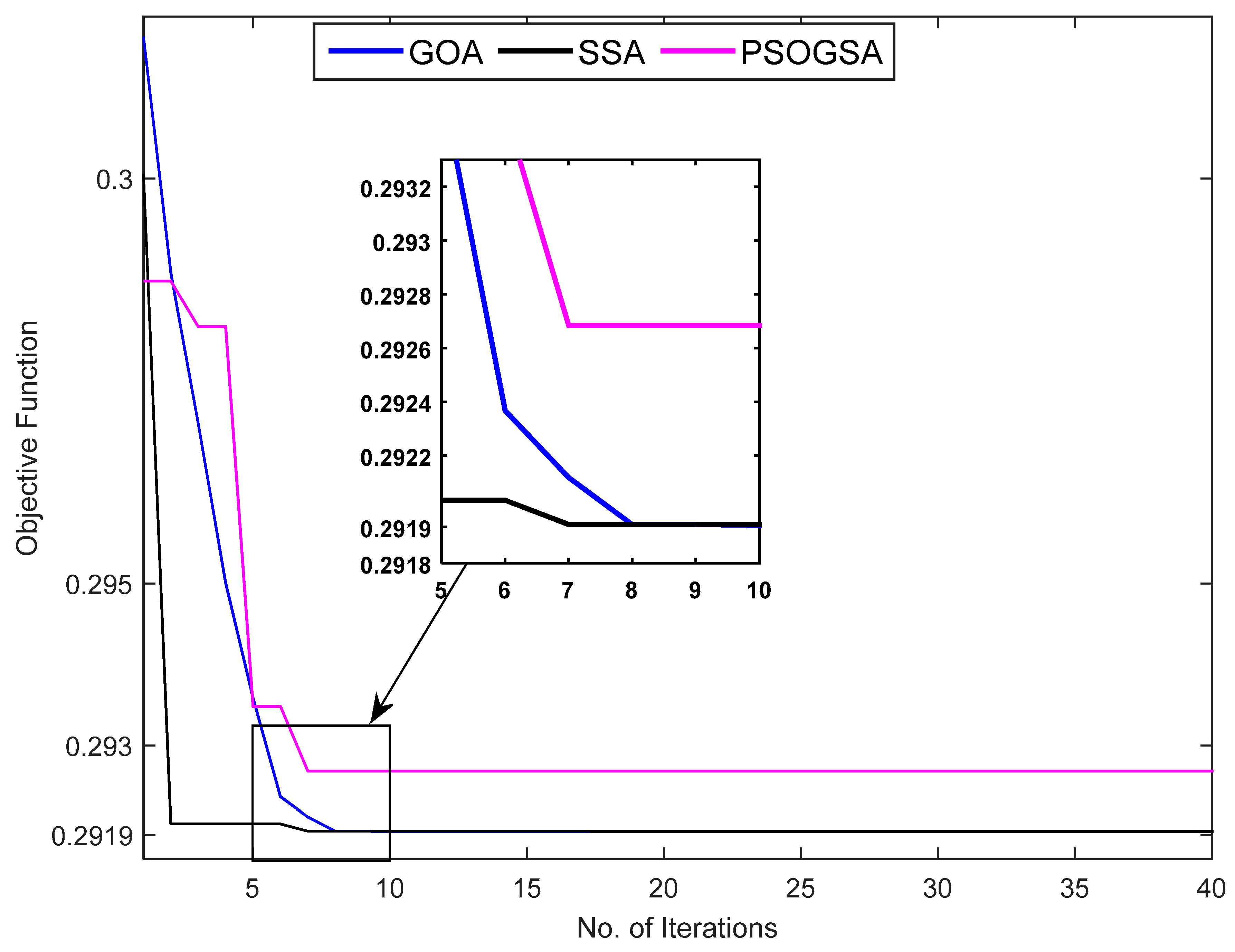
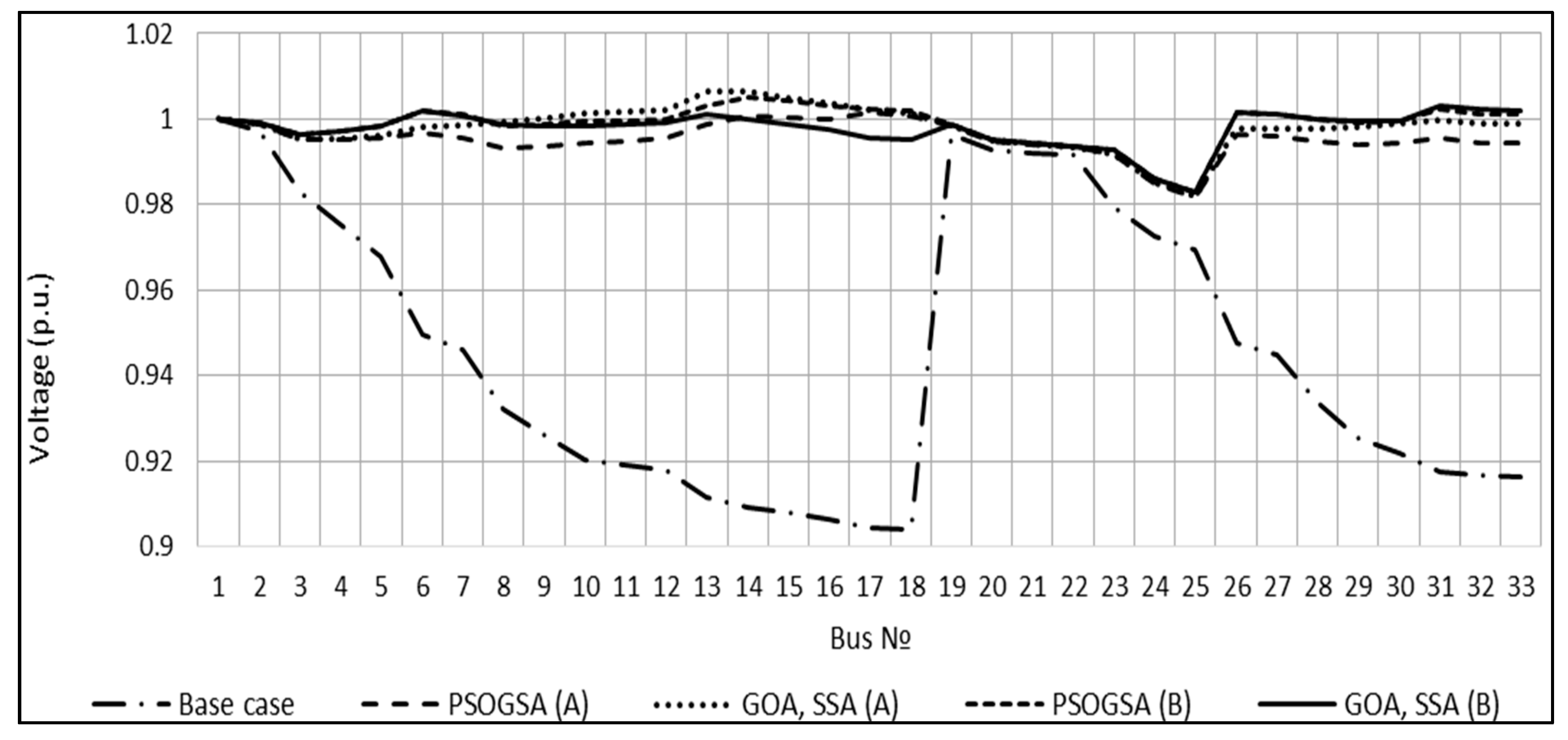
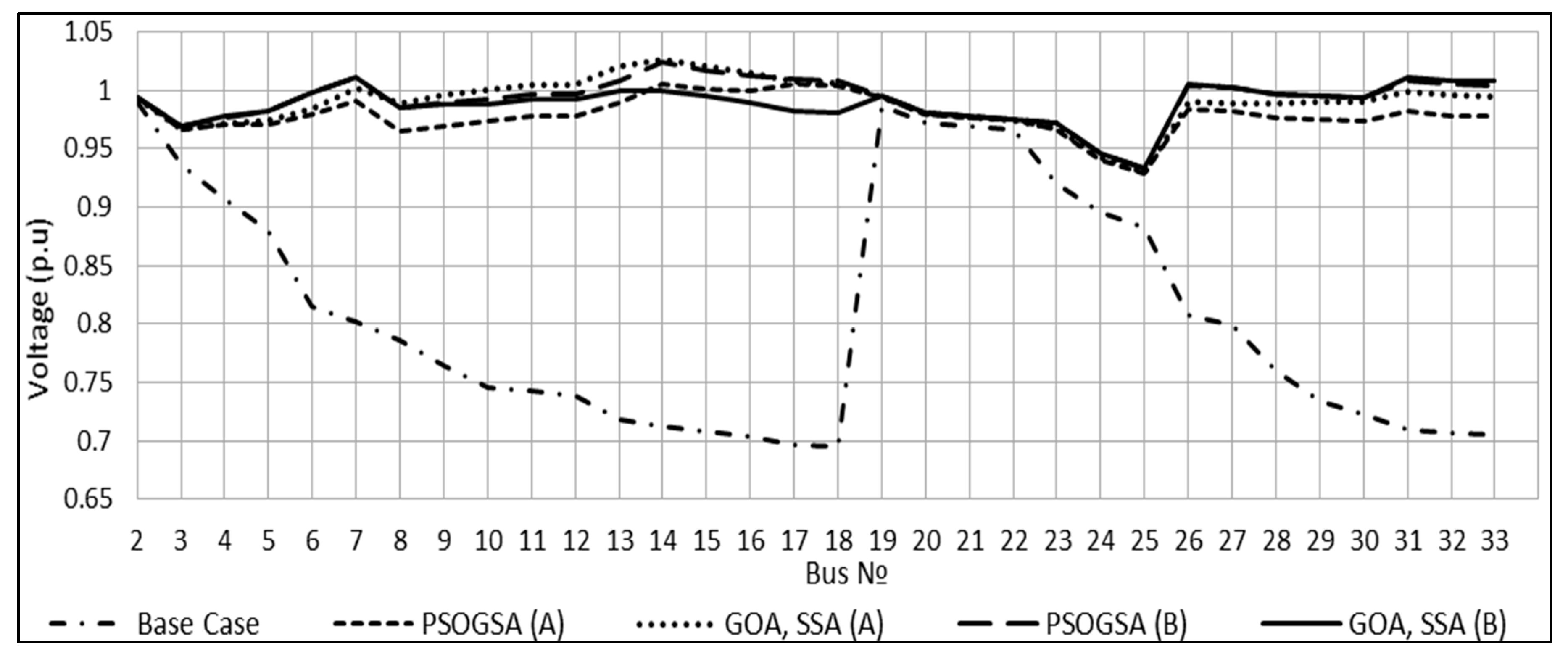
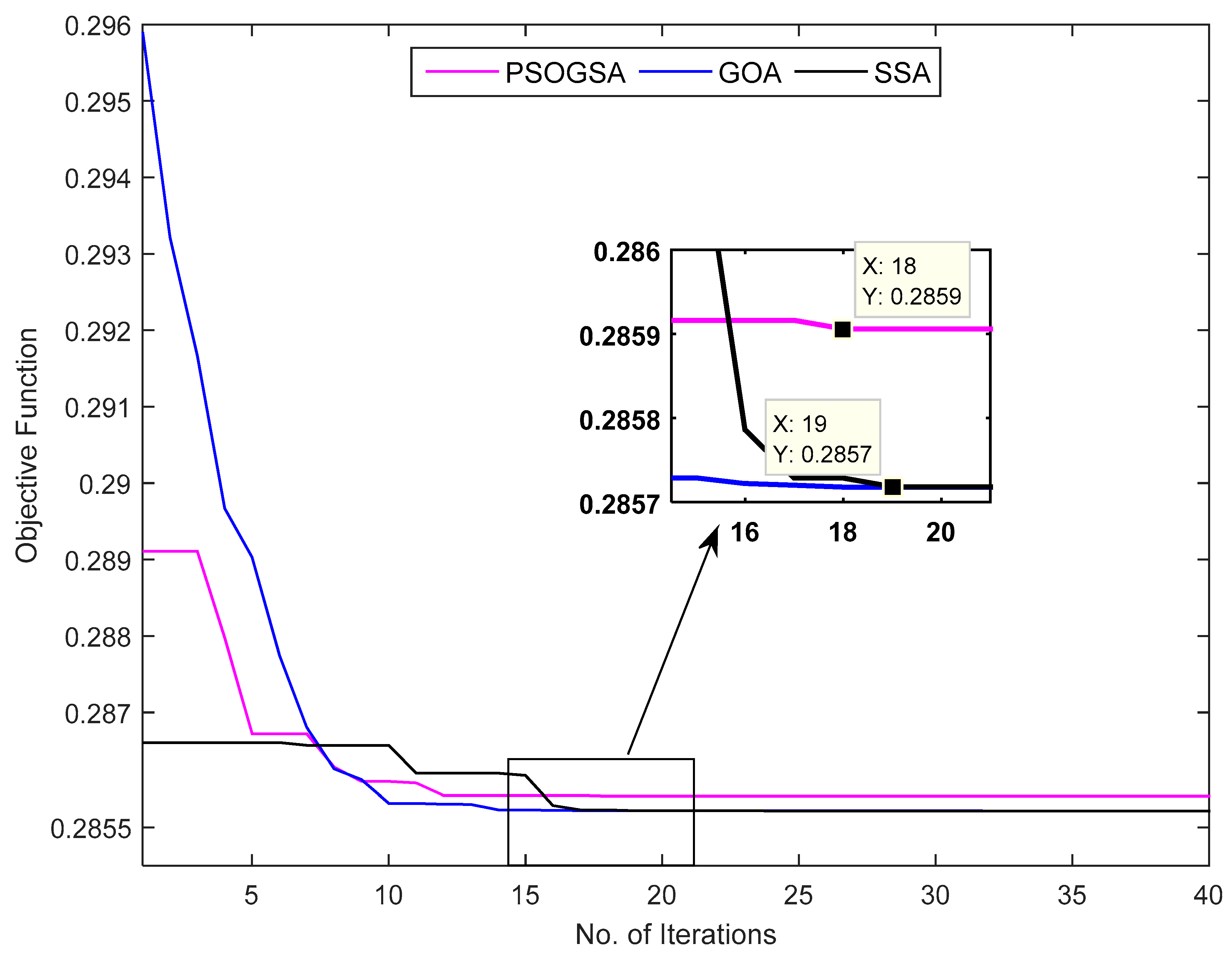

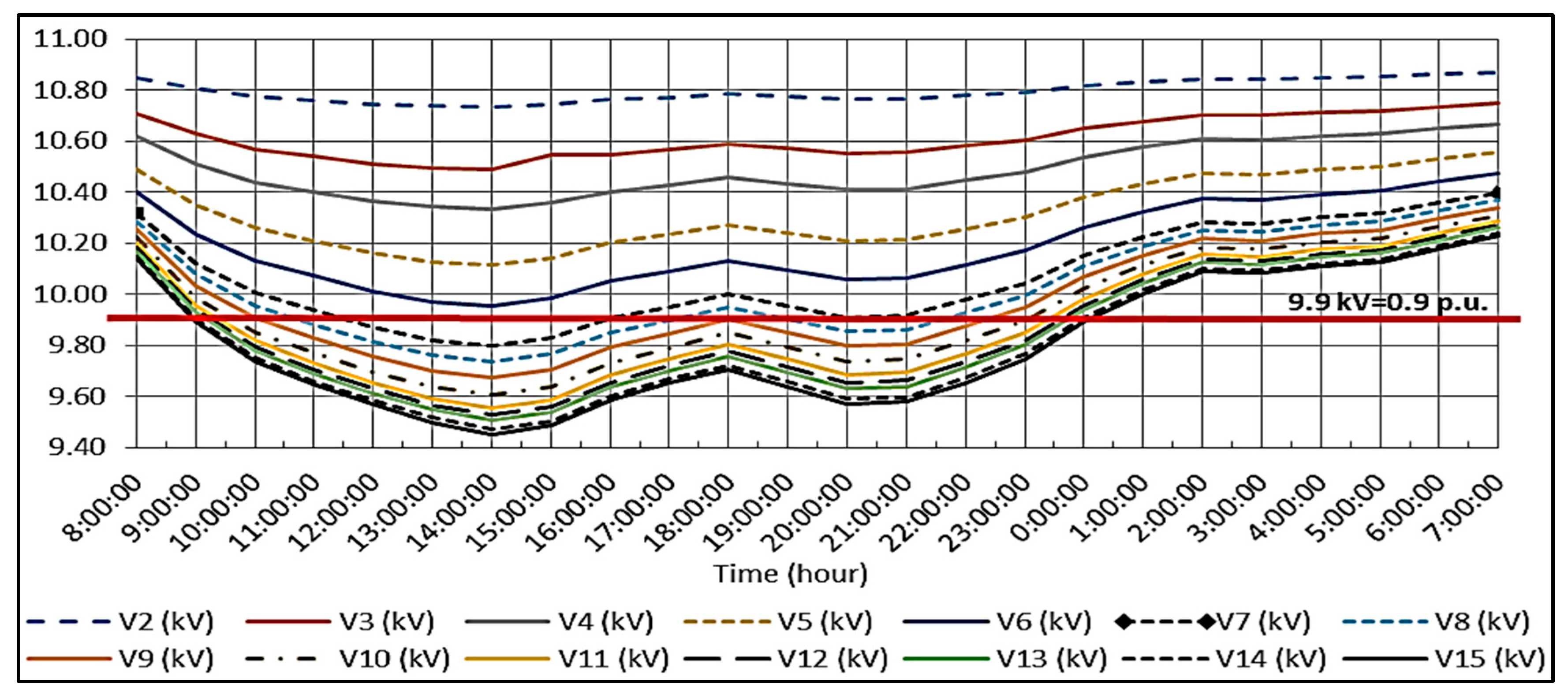
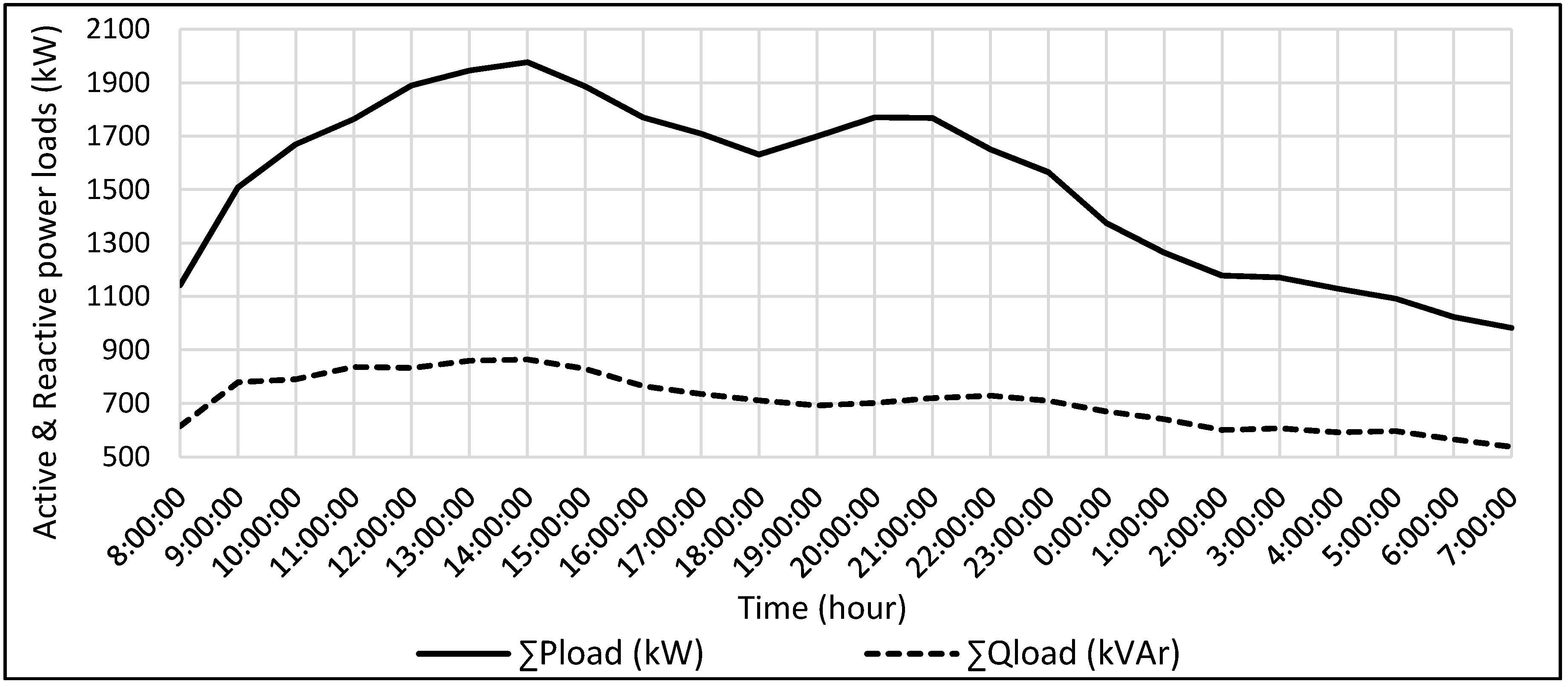
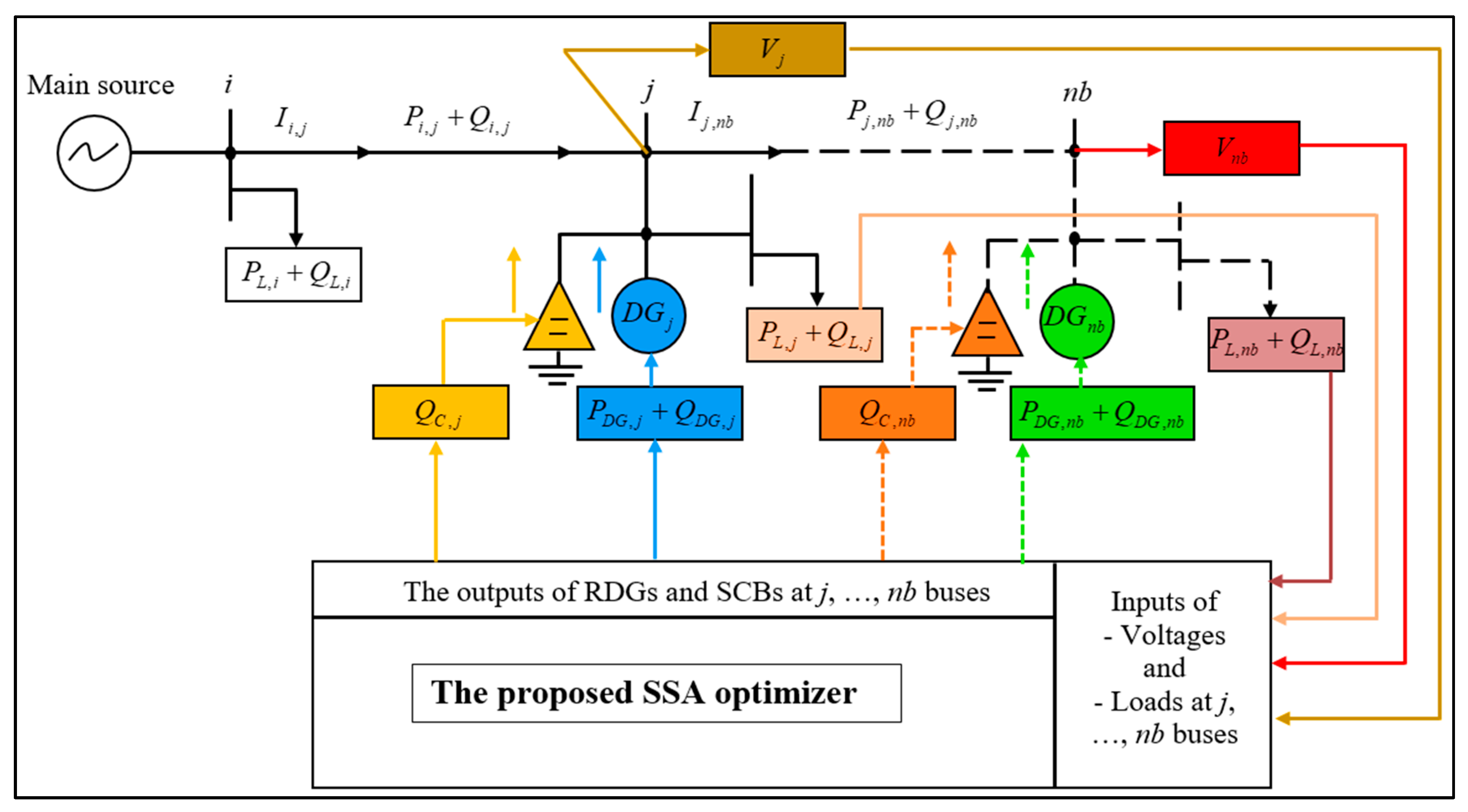
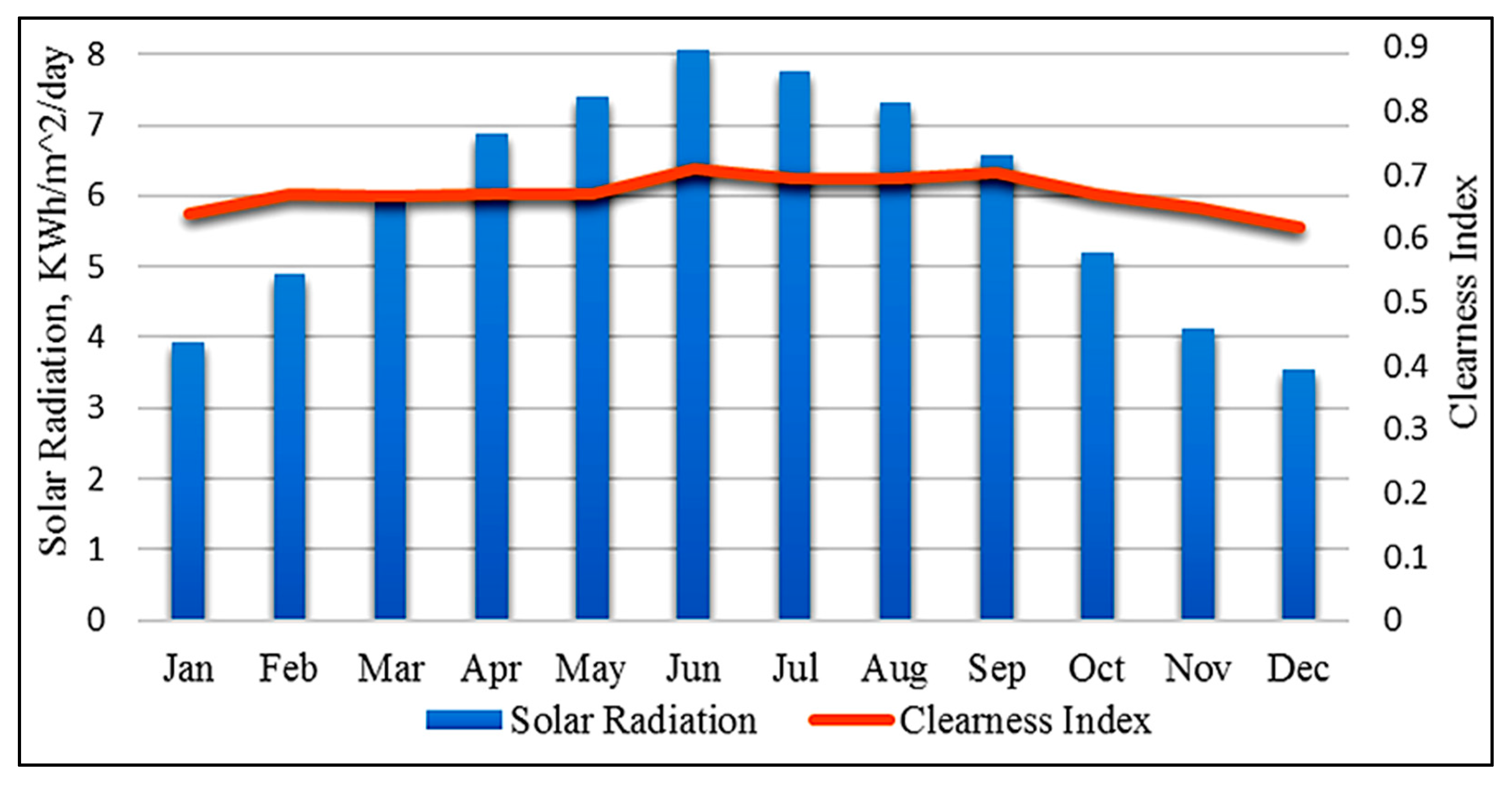
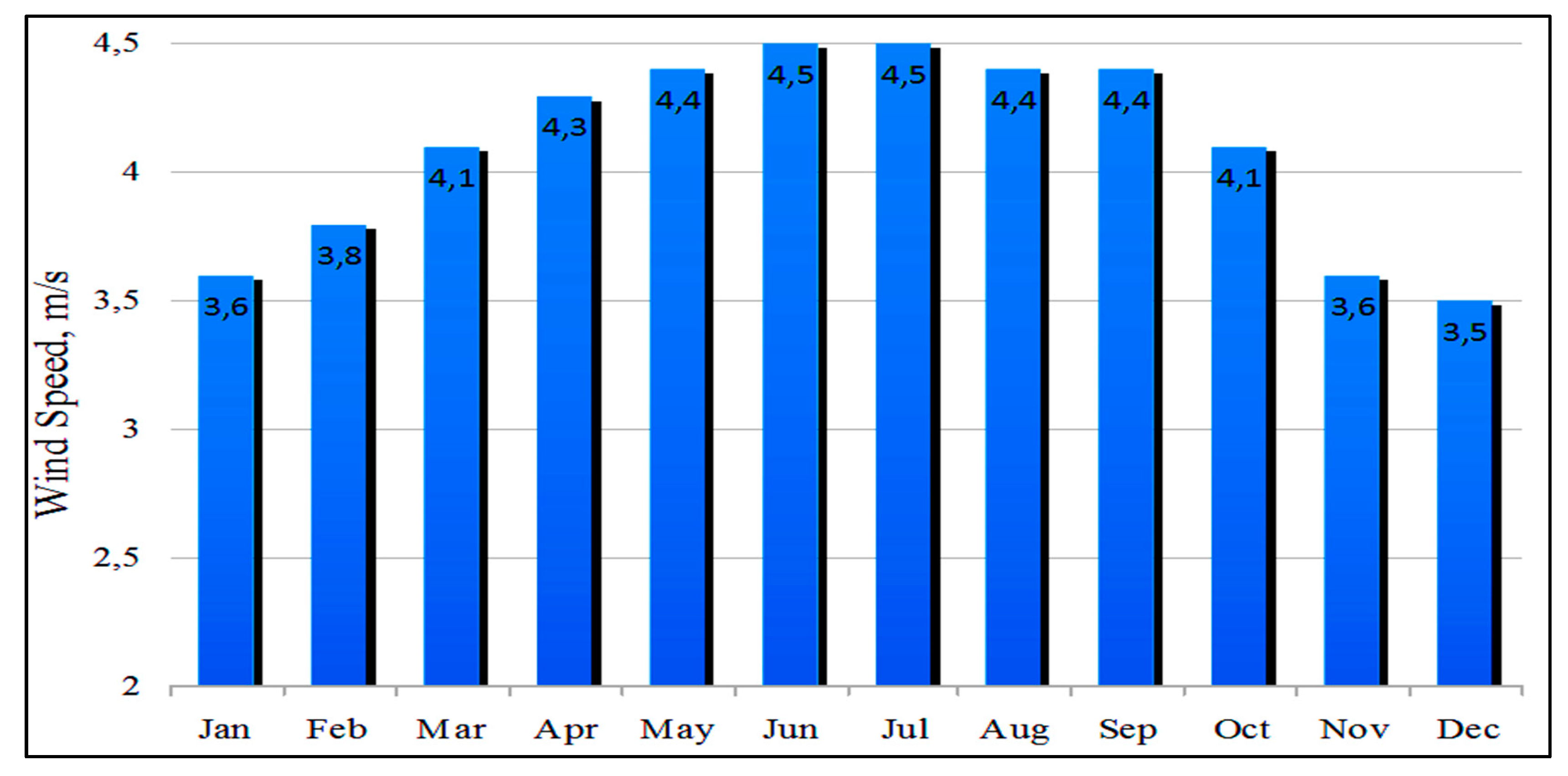
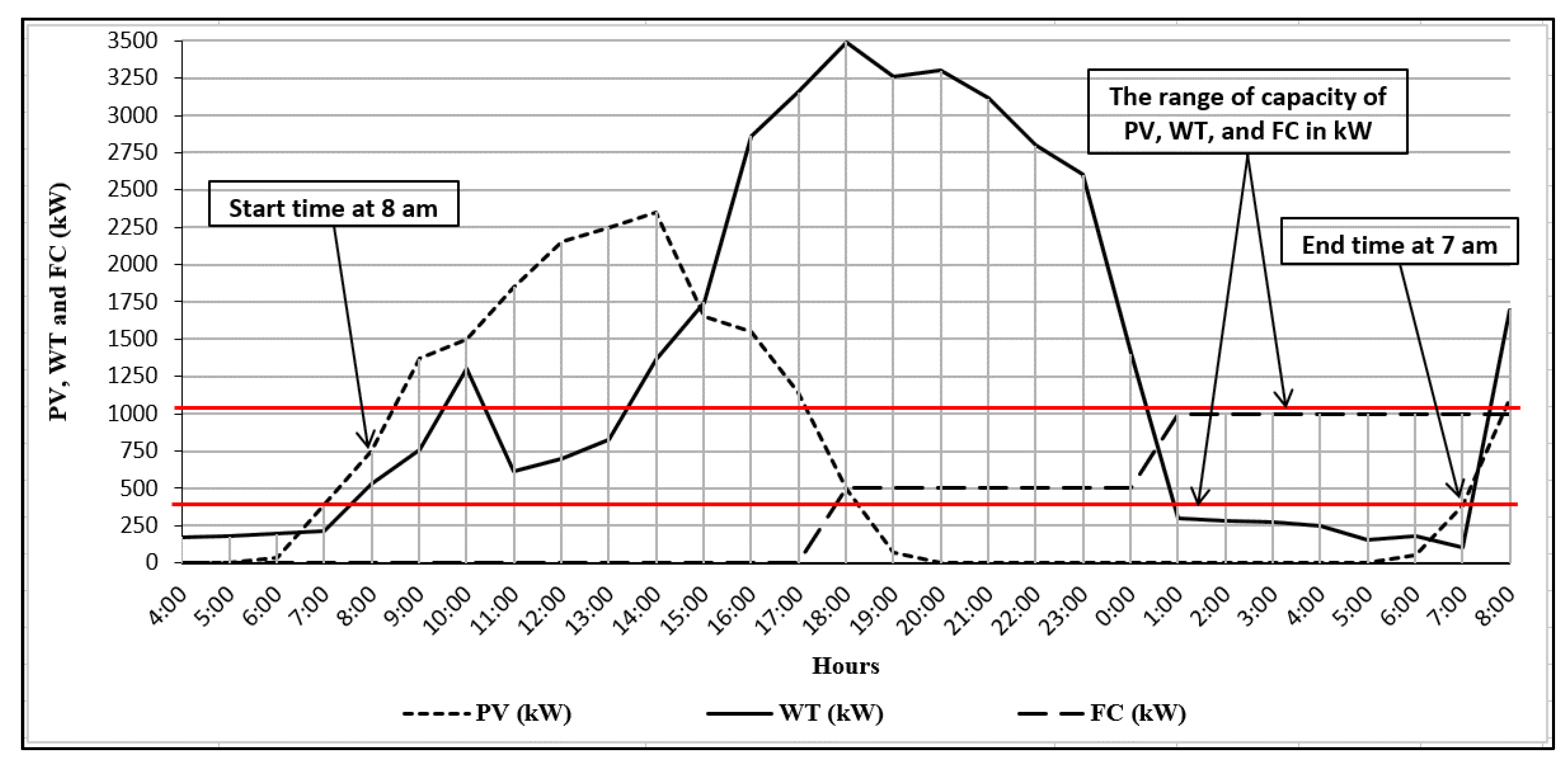
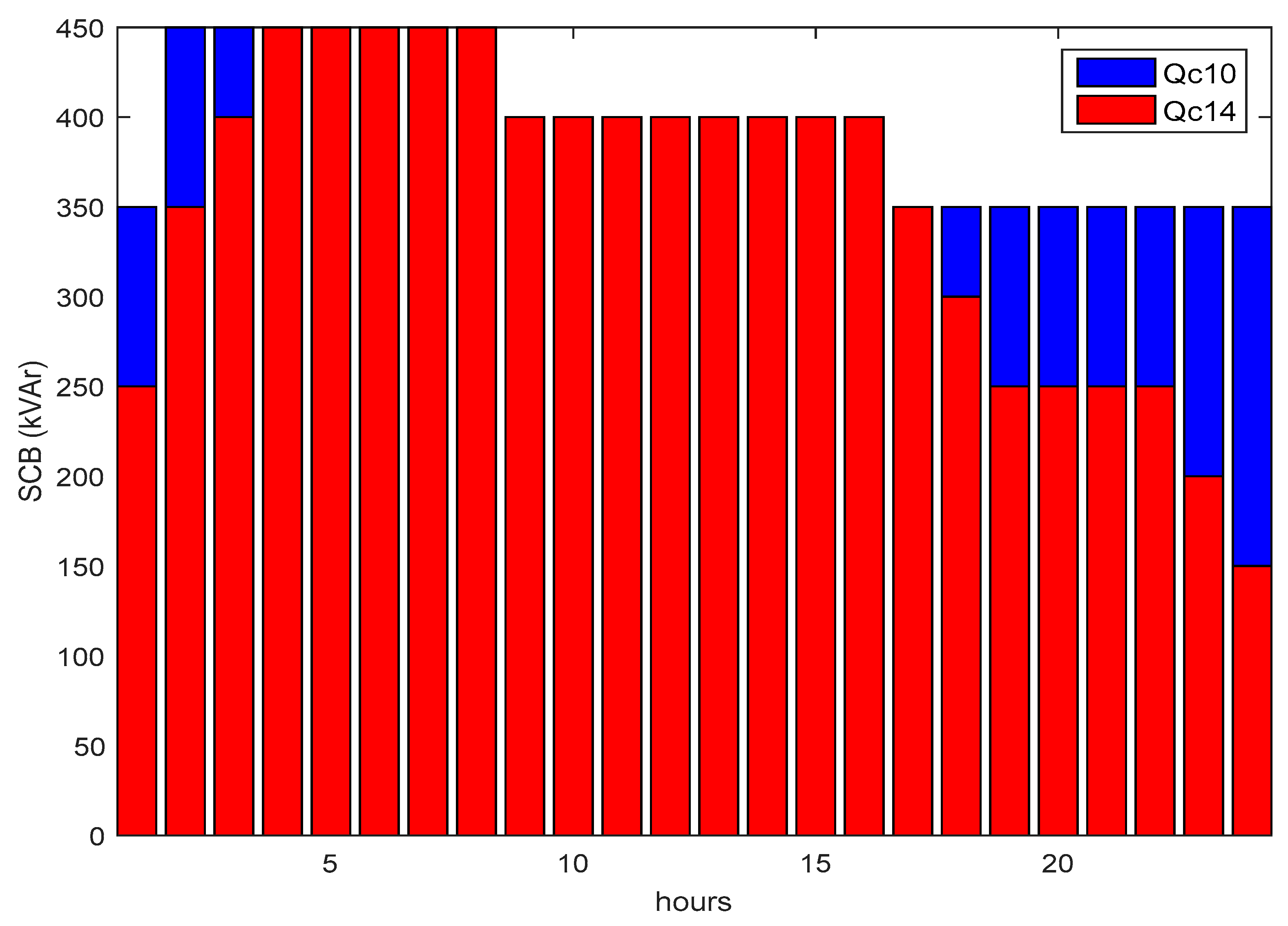
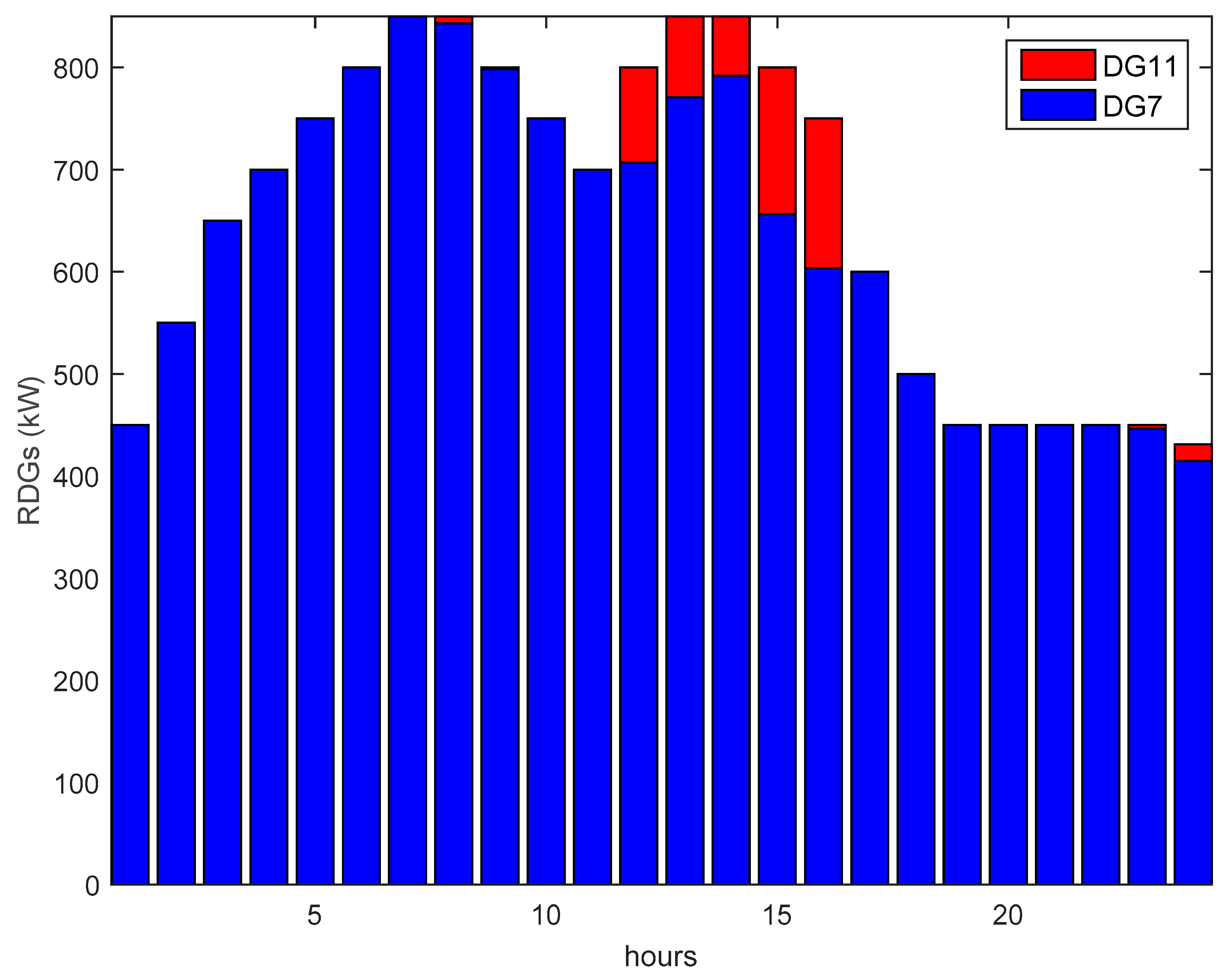
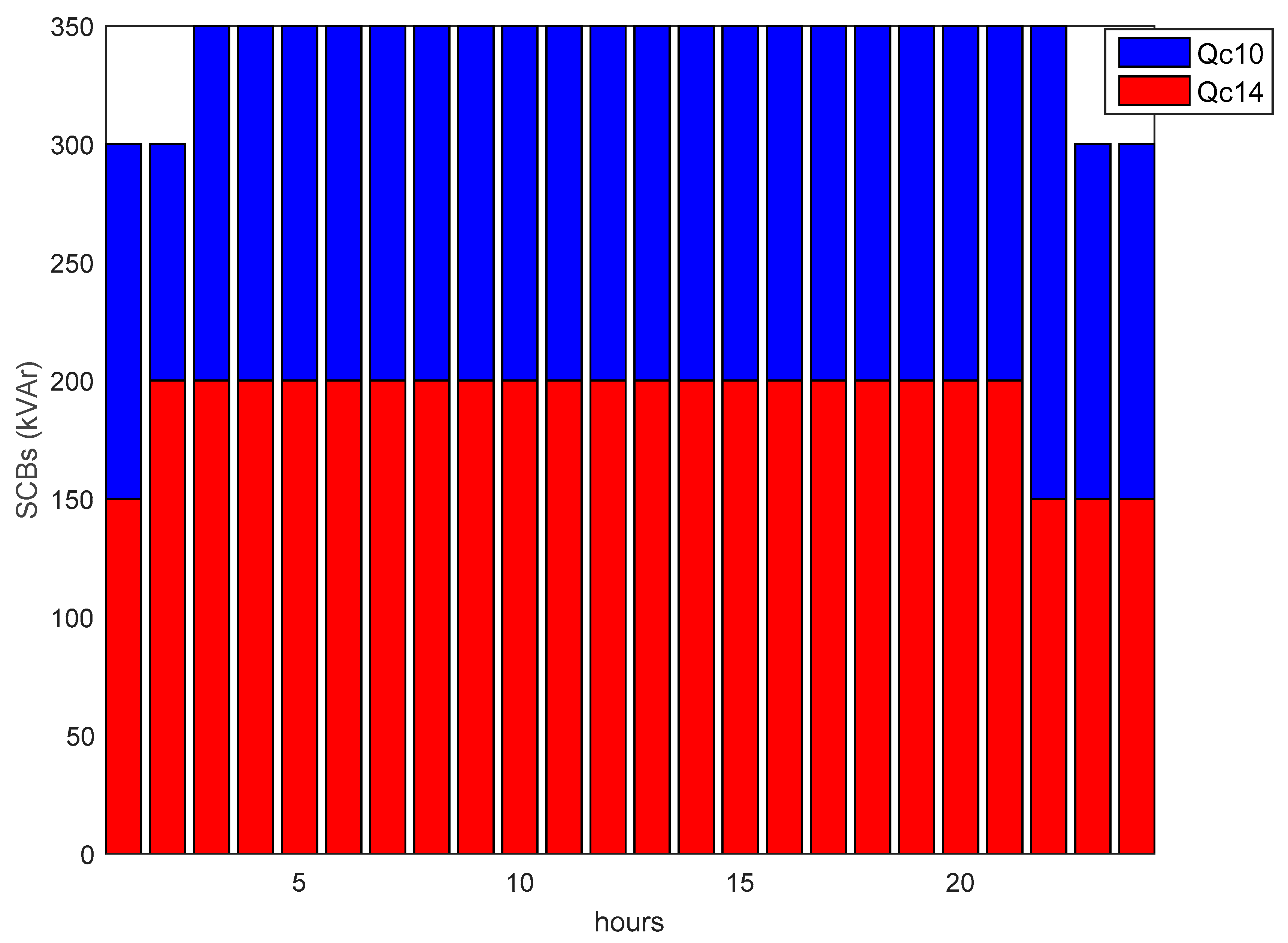
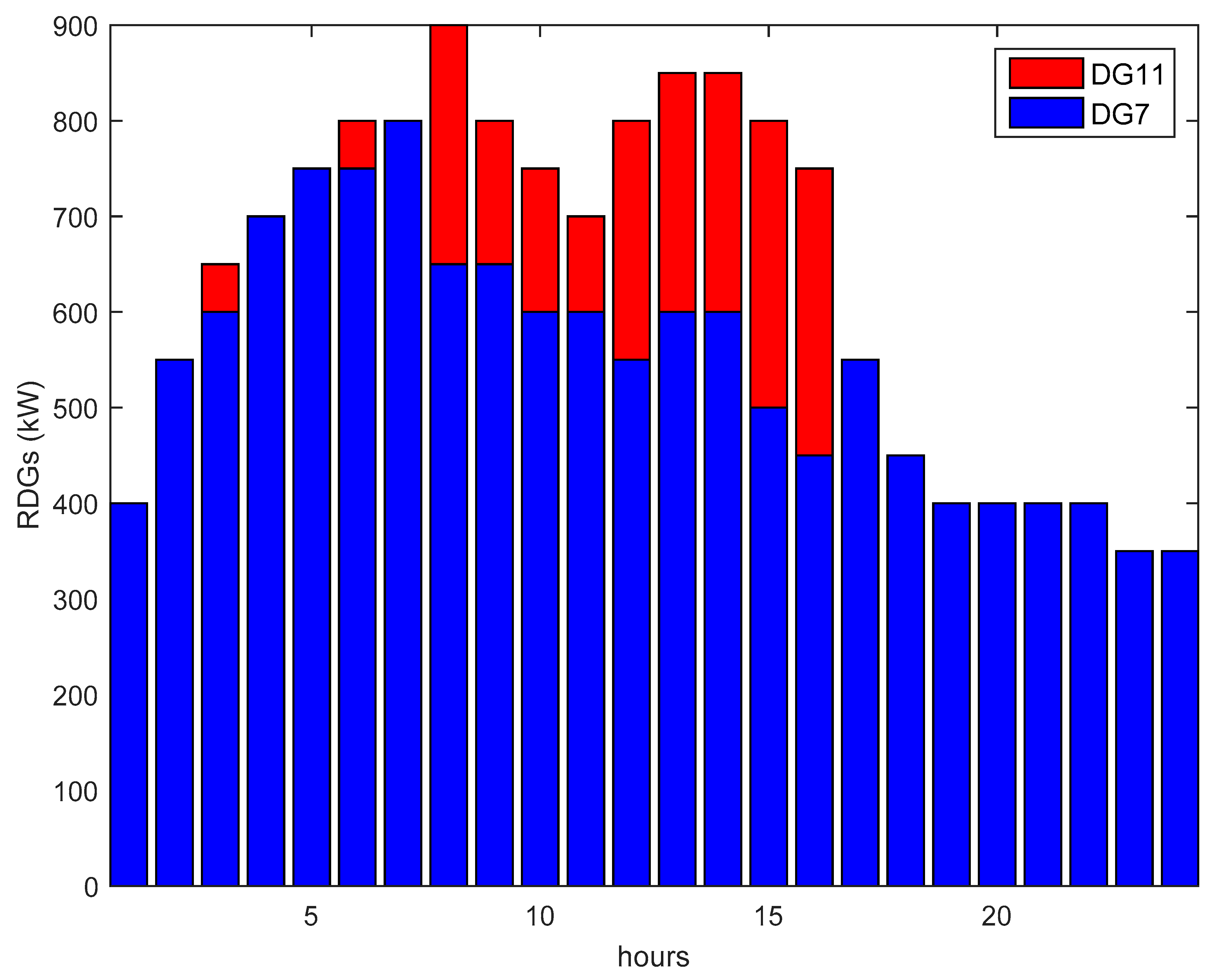
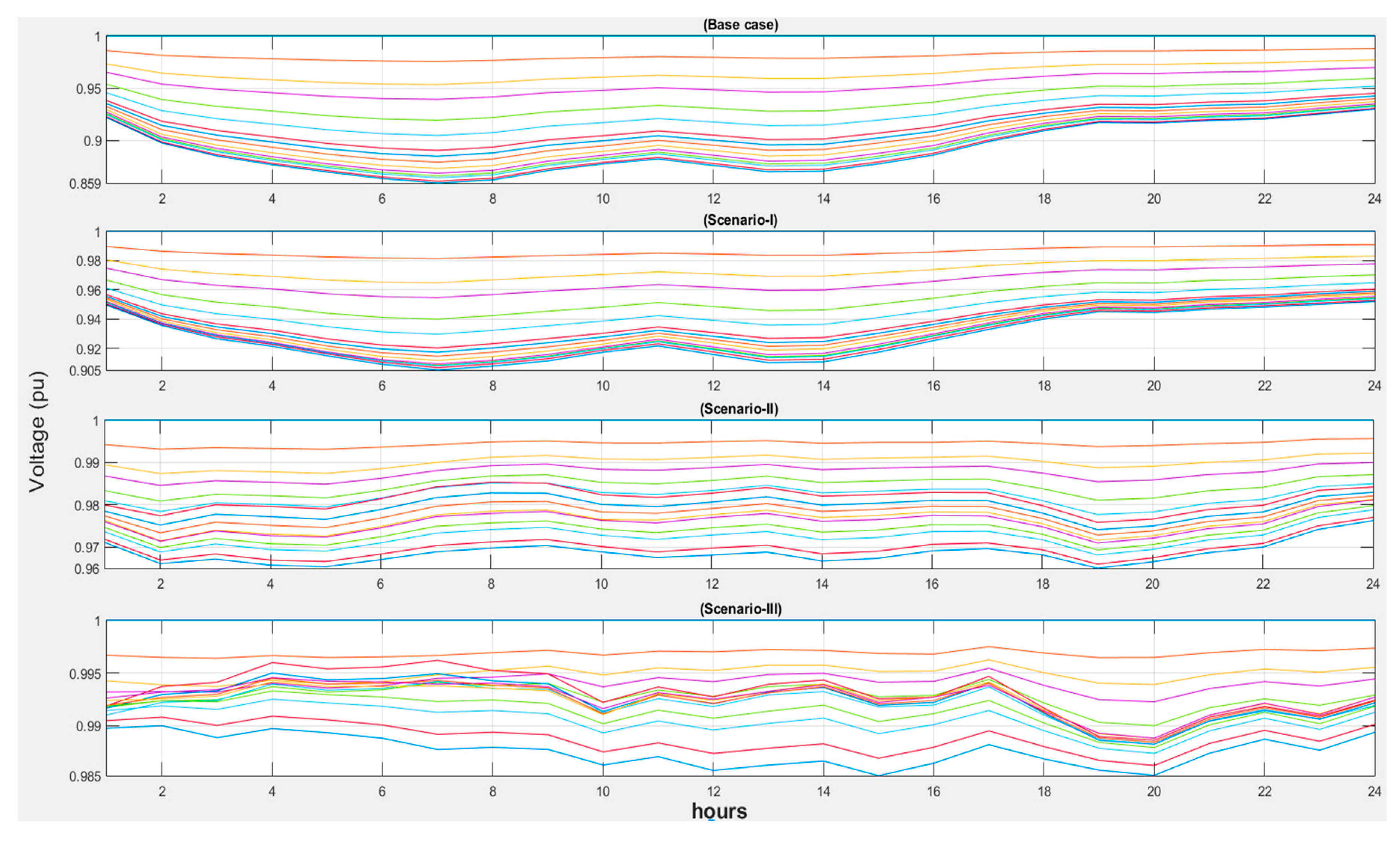
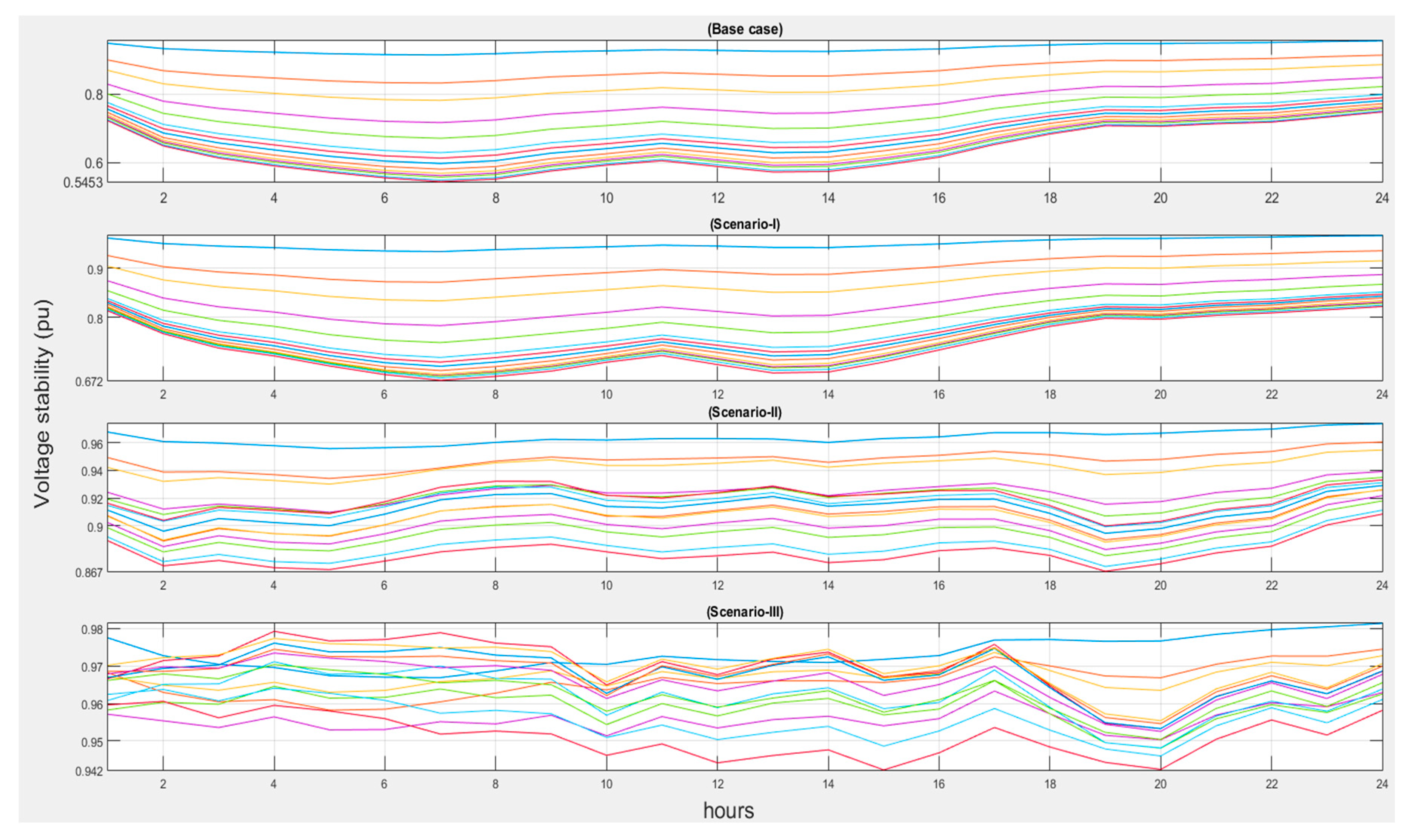
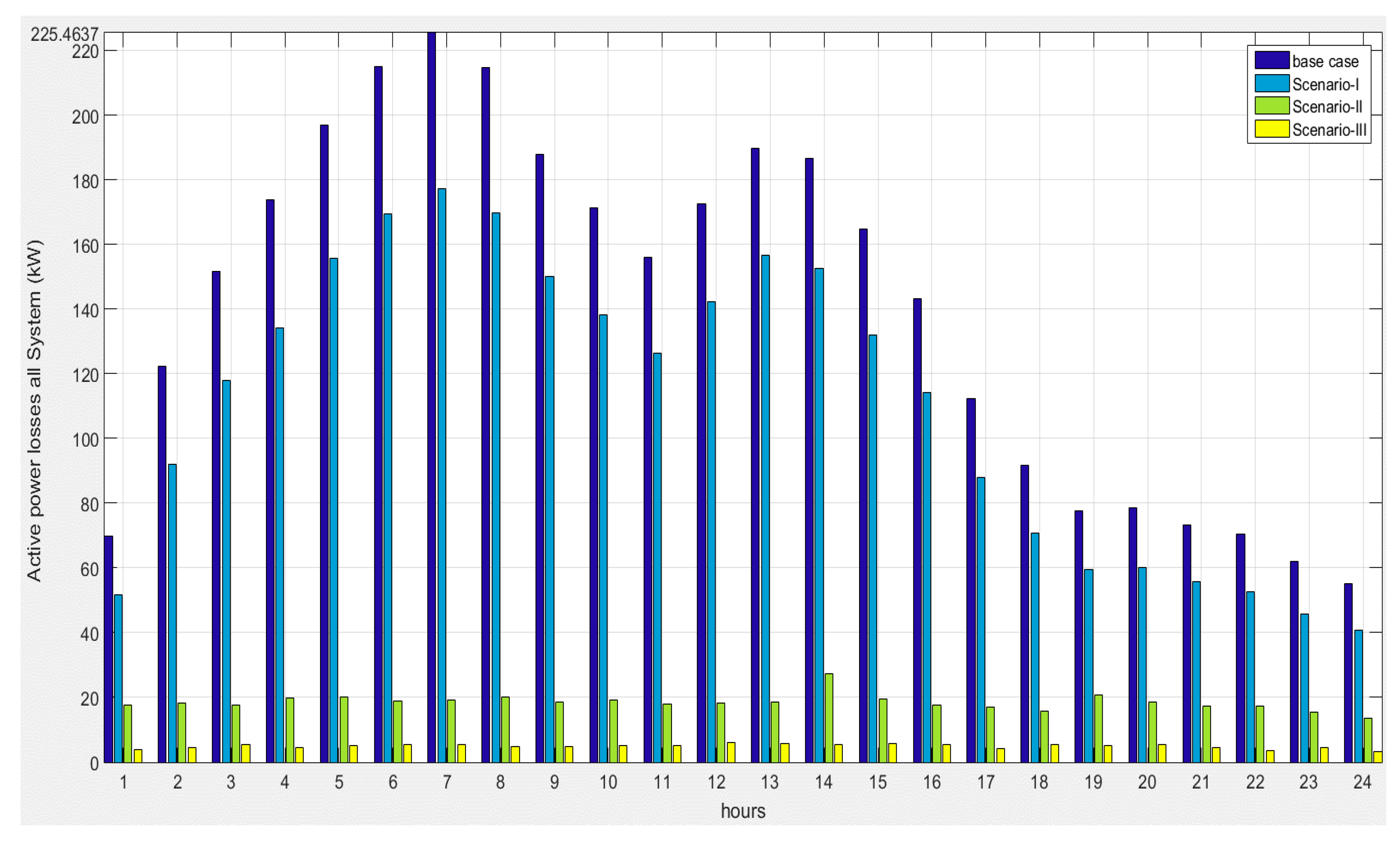
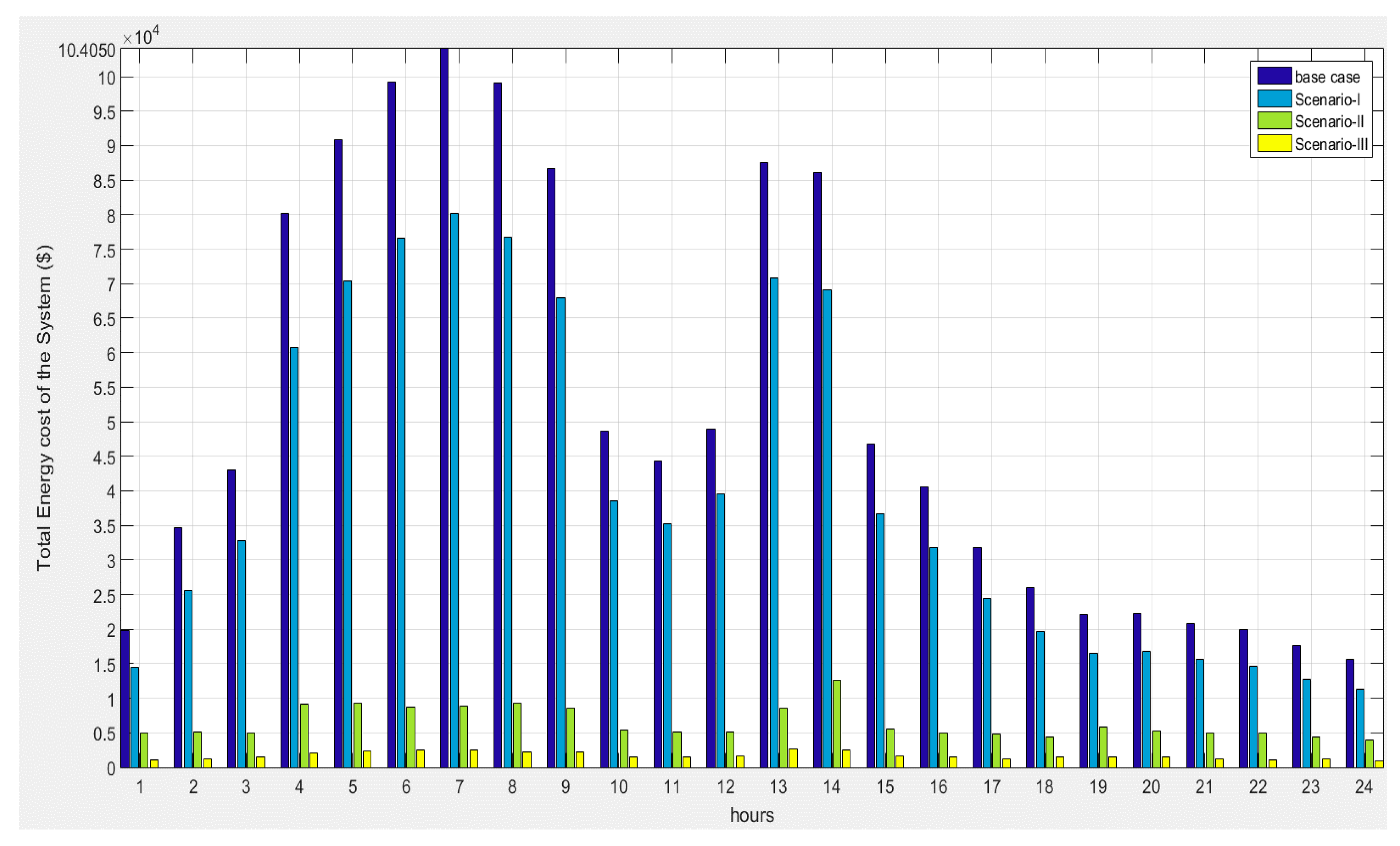
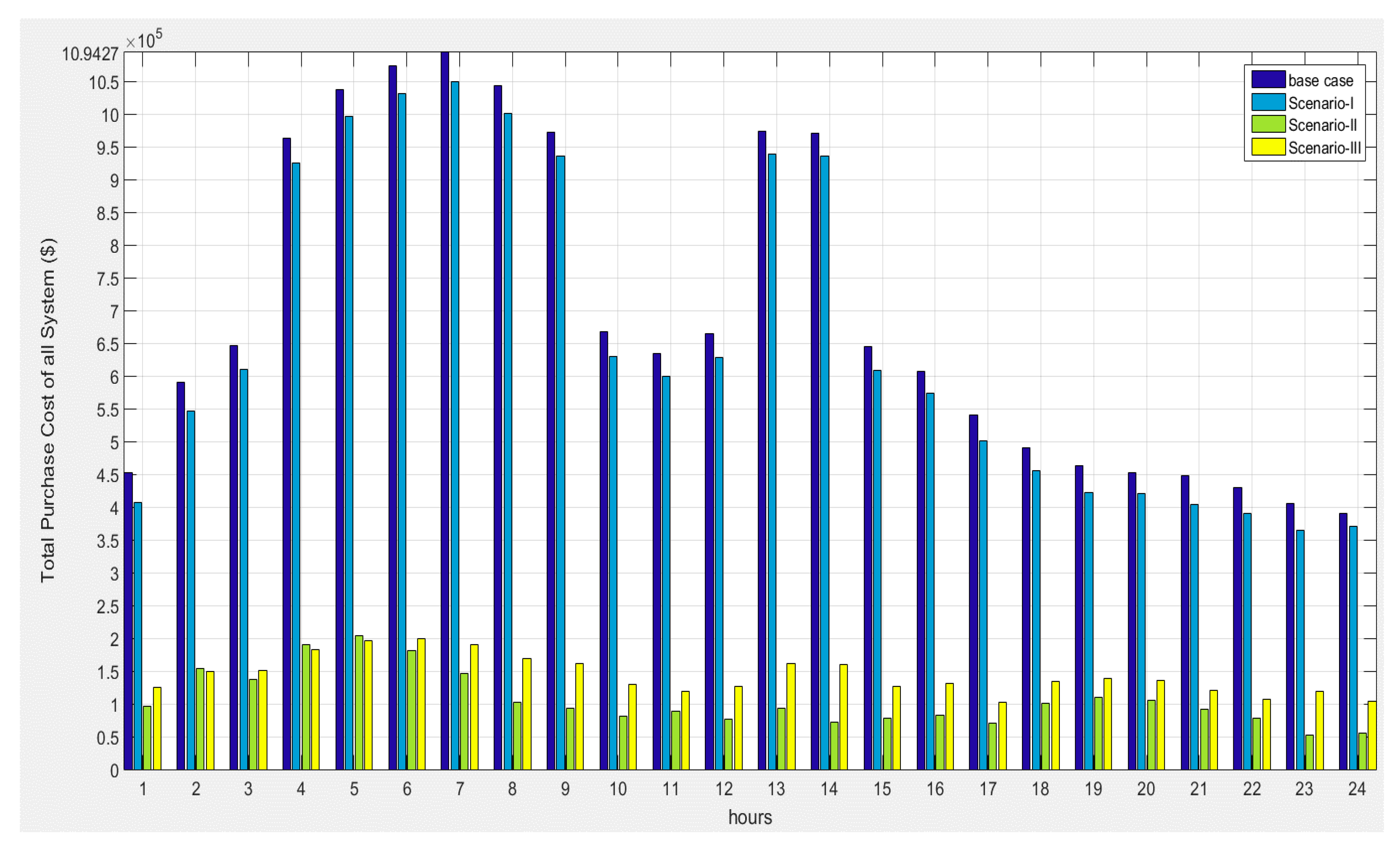
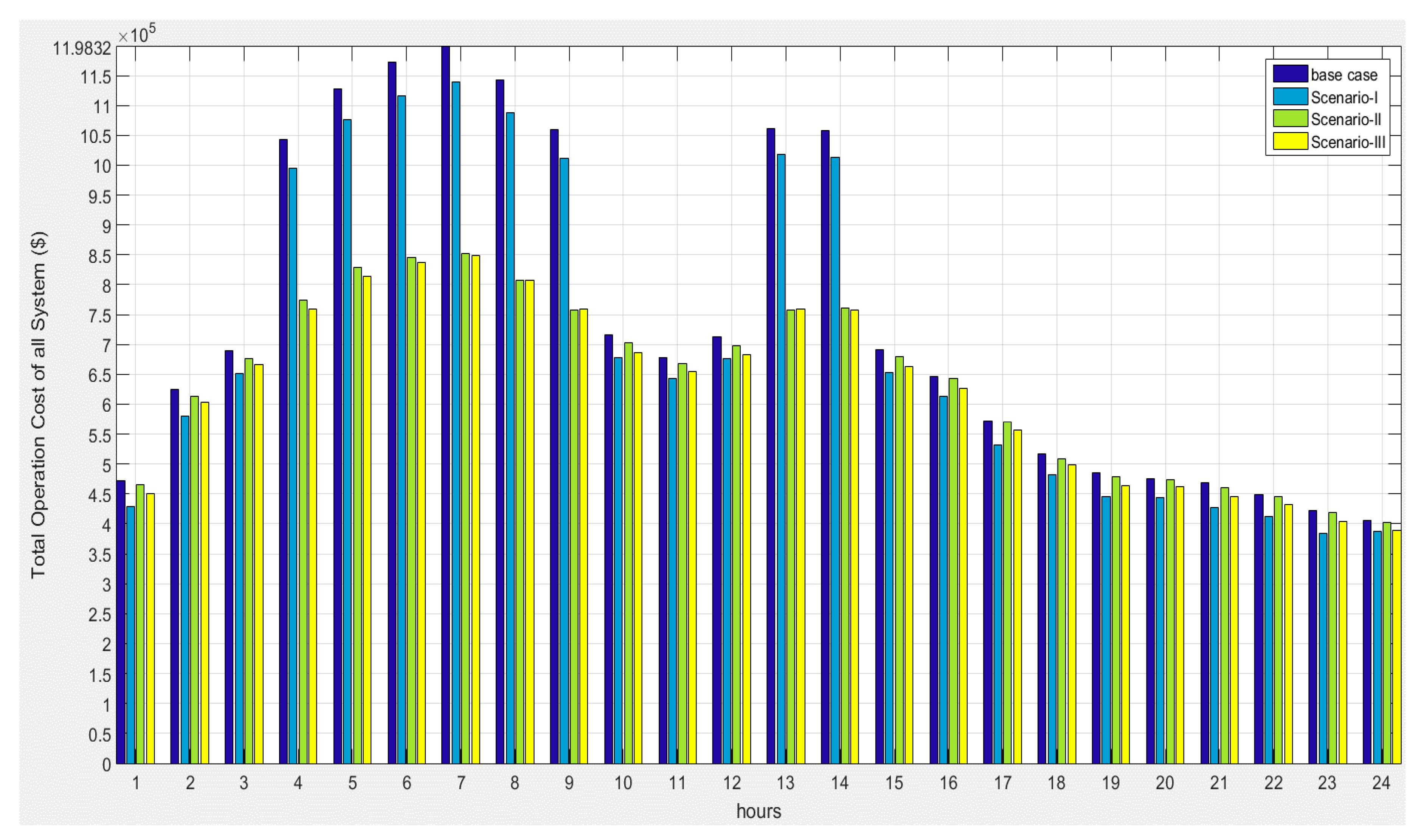
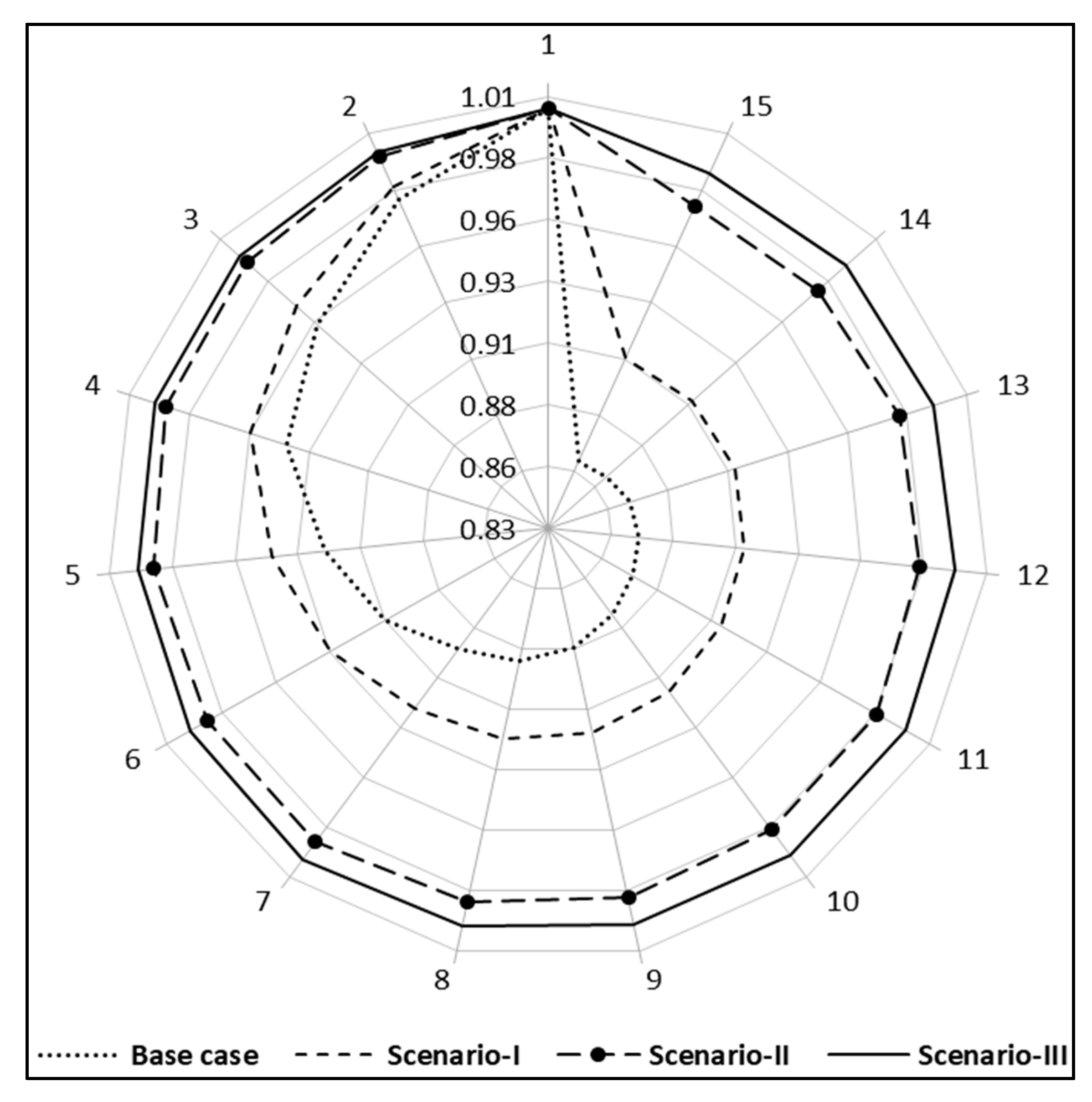

| Level | Grid State | Time Th (h/Year) | Emp Electricity Price ($/MWh) | Ke Energy Price ($/MWh) |
|---|---|---|---|---|
| 50% | light | 2920 | 35 | 25 |
| 100% | nominal | 4380 | 49 | 40 |
| 150% | peak | 1460 | 70 | 65 |
| Optimizer | Parameter Definition |
|---|---|
| PSOGSA | c1 = 0.5, c2 = 1.5, max. iterations = 20, no. of agents = 20, α = 23, GO = 1 |
| Gravitational Search Algorithm (GOA) | cmax = 1, cmin = 0.00004, f = 0.5, li = 1.5, max. iterations = 20, search agents = 20 |
| SSA | Max. iterations = 20, search agents = 20 |
| Iteration No. | DG-6 | DG-14 | DG-31 | Losses = P + j Q | Vmin | TOCT,DGSCB | ΔVIDev | ΔPlDGSCB | ΔOCDGSCB | MOFI | |||
|---|---|---|---|---|---|---|---|---|---|---|---|---|---|
| 1 | 1 | 1 | 1 | 780 | 780 | 780 | 22.4315 + j 17.2101 | 0.9817 | 10,716,599.74 | 0.3795 | 0.1063 | 0.8717 | 1.3575 |
| 2 | 0.4 | 0.5 | 0.1 | 780 | 748.08 | 780 | 22.2448 + j 17.0482 | 0.9816 | 10,729,763.43 | 0.3799 | 0.1054 | 0.8727 | 0.3194 |
| 3 | 0.3 | 0.6 | 0.1 | 780 | 780 | 780 | 22.4315 + j 17.2101 | 0.9817 | 10,716,599.74 | 0.3795 | 0.1063 | 0.8717 | 0.3468 |
| 4 | 0.2 | 0.7 | 0.1 | 780 | 780 | 780 | 22.4315 + j 17.2101 | 0.9817 | 10,716,599.74 | 0.3795 | 0.1063 | 0.8717 | 0.3741 |
| 5 | 0.1 | 0.8 | 0.1 | 780 | 780 | 780 | 22.4315 + j 17.2101 | 0.9817 | 10,716,599.74 | 0.3795 | 0.1063 | 0.8717 | 0.4014 |
| 6 | 0.5 | 0.4 | 0.1 | 780 | 748.08 | 780 | 22.2448 + j 17.0482 | 0.9816 | 10,729,763.43 | 0.3799 | 0.1054 | 0.8727 | 0.2919 |
| 7 | 0.5 | 0.3 | 0.2 | 780 | 748.08 | 780 | 22.2448 + j 17.0482 | 0.9816 | 10,729,763.43 | 0.3799 | 0.1054 | 0.8727 | 0.3412 |
| 8 | 0.5 | 0.2 | 0.3 | 780 | 748.08 | 780 | 22.2448 + j 17.0482 | 0.9816 | 10,729,763.43 | 0.3799 | 0.1054 | 0.8727 | 0.3905 |
| 9 | 0.5 | 0.1 | 0.4 | 780 | 780 | 780 | 22.4315 + j 17.2101 | 0.9817 | 10,716,599.74 | 0.3795 | 0.1063 | 0.8717 | 0.4398 |
| 10 | 0.6 | 0.1 | 0.3 | 780 | 748.08 | 780 | 22.2448 + j 17.0482 | 0.9816 | 10,729,763.43 | 0.3799 | 0.1054 | 0.8727 | 0.3631 |
| 11 | 0.6 | 0.2 | 0.2 | 780 | 748.08 | 780 | 22.2448 + j 17.0482 | 0.9816 | 10,729,763.43 | 0.3799 | 0.1054 | 0.8727 | 0.3138 |
| 12 | 0.7 | 0.2 | 0.1 | 780 | 780 | 780 | 22.4315 + j 17.2101 | 0.9817 | 10,716,599.74 | 0.3795 | 0.1063 | 0.8717 | 0.2374 |
| 13 | 0.8 | 0.1 | 0.1 | 780 | 780 | 780 | 22.4315 + j 17.2101 | 0.9817 | 10,716,599.74 | 0.3795 | 0.1063 | 0.8717 | 0.2102 |
| 14 | 0.4 | 0.1 | 0.5 | 780 | 780 | 780 | 22.4315 + j 17.2101 | 0.9817 | 10,716,599.74 | 0.3795 | 0.1063 | 0.8717 | 0.5163 |
| 15 | 0.3 | 0.1 | 0.6 | 780 | 780 | 780 | 22.4315 + j 17.2101 | 0.9817 | 10,716,599.74 | 0.3795 | 0.1063 | 0.8717 | 0.5928 |
| 16 | 0.2 | 0.1 | 0.7 | 780 | 780 | 780 | 22.4315 + j 17.2101 | 0.9817 | 10,716,599.74 | 0.3795 | 0.1063 | 0.8717 | 0.6694 |
| 17 | 0.1 | 0.1 | 0.8 | 780 | 780 | 780 | 22.4315 + j 17.2101 | 0.9817 | 10,716,599.74 | 0.3795 | 0.1063 | 0.8717 | 0.7459 |
| Items | Base Case | Scenario A | Scenario B | ||
|---|---|---|---|---|---|
| PSOGSA | GOA, SSA | PSOGSA | GOA, SSA | ||
| Total losses (kW) | 210.98 | 22.74 | 22.2448 | 20.0882 | 20.0207 |
| Loss reduction (%) | - | 89.21 | 89.456 | 90.47 | 90.51 |
| Energy cost ($) | 539,318.38 | 58,150.55 | 56,866.76 | 51,353.56 | 51,180.61 |
| Saving of energy cost ($) | - | 481,167.83 | 482,451.62 | 487,964.82 | 488,137.77 |
| Vmin (p.u) | 0.9037 | 0.9816 | 0.9819 | 0.9829 | 0.9829 |
| VSImin (p.u) | 0.6672 | 0.9285 | 0.9295 | 0.9334 | 0.9334 |
| Optimum RDGs siting/capacity (kVA)/optimum PF | - | 6/800/1 | 6/780/1 | 6/1274.75/0.9021 | 6/1193.6/1 |
| 13/700/1 | 14/748.08/1 | 13/700/1 | 14/701.94/0.9040 | ||
| 31/800/1 | 31/780/1 | 31/860.232/0.8137 | 31/810.83/0.8320 | ||
| ∑ kVA of DG (kVA) | - | 2300 | 2308.08 | 2834.98 | 2706.37 |
| Optimal capacitor location/size (kVAr) | - | 8/300 | 6/500 | 8/100 | 6/550 |
| 14/450 | 17/300 | 14/200 | 17/100 | ||
| 30/900 | 30/700 | 30/300 | 30/400 | ||
| ∑ kVAr of capacitor (kVAr) | - | 1650 | 1500 | 600 | 1050 |
| Capacitor installation cost ($) | - | 7950 | 7500 | 4800 | 6150 |
| O&M capacitor cost ($) | - | 13,132.2 | 13,132.2 | 13,132.2 | 13,132.2 |
| DG installation cost ($) | - | 920,000 | 923,235.48 | 1,126,163.426 | 1,082,198.26 |
| O&M DG cost ($) | - | 5,291,751.58 | 5,310,361.75 | 5,866,941.97 | 5,757,847.87 |
| Purchased real power cost covering losses ($) | 12,294,529.75 | 4,502,437.27 | 4,475,534.13 | 3,711,212.93 | 3,859,490.25 |
| Total annual operating cost (TOCT,DGSCB) ($) | 12,833,848.13 | 10,793,421.61 | 10,786,630.31 | 10,773,604.09 | 10,769,999.21 |
| Net saving ($) | - | 2,040,426.52 | 2,047,217.82 | 2,060,244.04 | 2,063,848.92 |
| Saving (%) | - | 15.8988 | 15.9517 | 16.0532 | 16.0813 |
| VDI | 0.42754 | 0.1624 | 0.1619 | 0.1615 | 0.1615 |
| ΔVIDev | - | 0.3799 | 0.3786 | 0.3777 | 0.3777 |
| ΔPlDGSCB | - | 0.1078 | 0.1054 | 0.0952 | 0.0949 |
| ΔOCDGSC | - | 0.8732 | 0.8727 | 0.8721 | 0.8718 |
| Total objective function (MOFI) | - | 0.2927 | 0.2919 | 0.2859 | 0.2857 |
| CPU (time speed) s/No. Iter. | 0.539 | 5.75/(7) | GOA: 6.84/(8), SSA: 5.30/(7) | 12.16/(18) | GOA: 13.14/(19), SSA: 10.84/(19) |
| Item | Acronym | Equation |
|---|---|---|
| Relative error | RE | |
| Mean absolute error | MAE | |
| Root mean square error | RMSE | |
| Standard deviation | SD | |
| Efficiency | Eff |
| Scenario | Technique | Best Minimum Value of Objective Function MOFIbest | Worst Value of Objective Function MOFIWorst | Median | SD | Average RE % | MAE (Mean Absolute Error) | RMSE (Root Mean Square Error) | Efficiency % |
|---|---|---|---|---|---|---|---|---|---|
| Scenario A | GOA | 0.2919 | 0.2919 | 0.2919 | 1.6951 × 10−8 | 5.2109 × 10−9 | 5.0709 × 10−11 | 1.7420 × 10−10 | 100.0000 |
| SSA | 0.2919 | 0.2919 | 0.2919 | 2.3554 × 10−10 | 4.4890 × 10−11 | 4.3684 × 10−13 | 2.3567 × 10−12 | 100.0000 | |
| PSOGSA | 0.2919 | 0.2938 | 0.2927 | 0.0278 | 0.0881 | 8.5692 × 10−4 | 8.9957 × 10−4 | 99.7074 | |
| Scenario B | GOA | 0.2857 | 0.2857 | 0.2857 | 1.4748 × 10−6 | 6.3049 × 10−7 | 6.0047 × 10−9 | 1.0785 × 10−5 | 99.9974 |
| SSA | 0.2857 | 0.2859 | 0.2857 | 5.5412 × 10−4 | 1.3120 × 10−4 | 1.2495 × 10−6 | 5.5895 × 10−6 | 99.9996 | |
| PSOGSA | 0.2857 | 0.2861 | 0.2860 | 0.0088 | 0.0307 | 2.9250 × 10−4 | 3.0501 × 10−4 | 99.8977 |
| Items | Base Case | Scenario I | Scenario II | Scenario III |
|---|---|---|---|---|
| Total Losses (kW) | 225.4637 | 177.1717 | 15.0768 | 5.5753 |
| Loss Reduction (%) | - | 21.4177 | 93.31 | 97.5271 |
| Energy Cost ($) | 104,050.42 | 81,763.89 | 6957.87 | 2572.98 |
| Saving of Energy Cost ($) | - | 22286.53 | 97,092.55 | 101,477.43 |
| Vmin (p.u)/Bus (15) | 0.8593 | 0.9053 | 0.9727 | 0.9877 |
| VSImin (p.u)/Bus (15) | 0.5453 | 0.6718 | 0.8951 | 0.9518 |
| Power Factor (PF) | 0.8950 | 0.9992 | 0.5219 | 0.9987 |
| Optimal DG Siting/Capacity (kVA)/Optimum PF | - | - | (7)/894.42/0.8944 (11)/900/1 | (7)/854.40/0.9363 (11)/800/1 |
| ∑ kVA of DG (kVA) | - | - | 1794.42 | 1654.40 |
| Optimal Capacitor Location/Size (kVAr) | - | (10) 450 (14) 450 | - - | (10) 350 (14) 200 |
| ∑ kVAr of capacitor (kVAr) | - | 900 | - | 550 |
| Capacitor Installation and O&M Cost ($) | - | 14100 | - | 11,426.9 |
| DG installation and O&M cost ($) | - | - | 689,515.56 | 648,955.82 |
| Purchased Active Power Cost including Losses ($) | 1,094,265.37 | 1,070,264.49 | 144,812.78 | 189,790.09 |
| Total Operating Cost (TOCT,DGSCB) ($) | 1,198,315.79 | 1,157,214.68 | 841,286.22 | 852,745.80 |
| Net Saving ($) | - | 41,101.10 | 357,029.57 | 345,569.98 |
| Saving (%) | - | 3.4299 | 29.79 | 28.8380 |
| VDI | 0.3700 | 0.2383 | 0.1607 | 0.1672 |
| ΔVIDev | - | 0.6440 | 0.4342 | 0.4518 |
| ΔPlDGSCB | - | 0.7858 | 0.0669 | 0.0247 |
| ΔOCDGSCB | - | 0.9657 | 0.7021 | 0.7116 |
| Total Objective Function (MOFI) | - | 0.7471 | 0.2773 | 0.2636 |
© 2018 by the authors. Licensee MDPI, Basel, Switzerland. This article is an open access article distributed under the terms and conditions of the Creative Commons Attribution (CC BY) license (http://creativecommons.org/licenses/by/4.0/).
Share and Cite
Tolba, M.; Rezk, H.; Diab, A.A.Z.; Al-Dhaifallah, M. A Novel Robust Methodology Based Salp Swarm Algorithm for Allocation and Capacity of Renewable Distributed Generators on Distribution Grids. Energies 2018, 11, 2556. https://doi.org/10.3390/en11102556
Tolba M, Rezk H, Diab AAZ, Al-Dhaifallah M. A Novel Robust Methodology Based Salp Swarm Algorithm for Allocation and Capacity of Renewable Distributed Generators on Distribution Grids. Energies. 2018; 11(10):2556. https://doi.org/10.3390/en11102556
Chicago/Turabian StyleTolba, Mohamed, Hegazy Rezk, Ahmed A. Zaki Diab, and Mujahed Al-Dhaifallah. 2018. "A Novel Robust Methodology Based Salp Swarm Algorithm for Allocation and Capacity of Renewable Distributed Generators on Distribution Grids" Energies 11, no. 10: 2556. https://doi.org/10.3390/en11102556
APA StyleTolba, M., Rezk, H., Diab, A. A. Z., & Al-Dhaifallah, M. (2018). A Novel Robust Methodology Based Salp Swarm Algorithm for Allocation and Capacity of Renewable Distributed Generators on Distribution Grids. Energies, 11(10), 2556. https://doi.org/10.3390/en11102556








